Nature Conservation 2024 — 30. 5. 2024 — Články bez rubriky — Print article in pdf
Summary of 2023 Issues
On Nature in the Czech Republic

Jaskula F.: Fifty Years of the Beskydy/Beskids Mts. Protection and Conservation
Fifty years ago, exactly on 5 March 1973 the Beskydy/Beskids Mts. Protected Landscape Area (PLA) was declared in north-eastern Moravia (Moravian-Silesian Region). At that time communist regime was “enthusiastically” being built and many currently inconceivable intentions had targeted just the Beskydy/Beskids Mts., e,g, support to building weekend cottages for workers from the Ostrava industrial region there or transformation of mountain pastures and meadows into arable land to compensate fields destroyed during coal mining. New infrastructure was being developed in valleys, people were leaving traditional wooden buildings with small fields on mountain slopes and moving into centres of municipalities. Therefore, forest was spreading on hills as well as buildings in valleys. Meadows and pastures including sheep, orchids and insects were declining. The age of sharp political changes after November 1989 became crucial for nature conservation there. The public clearly declared its interest in and concerns for nature and the healthy environment. New modern Act No. 114/1992 Gazette on Nature Conservation and Landscape Protection has radically changed and enhanced the Beskydy/Beskids Mts. PLA Administration role. The Beskydy/Beskids Mts. would have been be there without the PLA anyhow. Moreover, they would be more built-up, more forested, without most of small-size Specially Protected Areas within them, with lower species richness, less picturesque. Hoping that the beauty and uniqueness will be maintained in the Beskydy/Beskids Mts. If somebody will consider their protection and conservation after the next fifty years, we wish he said: “It has been making sense.”
Březina S., Hrázský Z., Krause D., Materna J., Čejková A., Josefovičová A., Mikslová K., Harčariková L., Horáková V. & Zavadil V.: Krkonoše/Giant Mts. Alpine Treeless Area, a Czech Family Silver
The Krkonoše/Giant Mts. tundra is one of the most important phenomena protected by the Krkonoše/Giant Mts. National Park, in 2023 celebrating 60 years since its declaration. The unique flora and fauna include there particularly the whitebeam Sorbus sudetica, Cloudberry, also now as the Nordic berry (Rubus chamaemorus), Daisy-leaved speedwell (Veronica bellidiodes), Fernweed or Sudetic lousewort (Pedicularis sudetica subsp. sudetica), Azure hawker (Aeshna caerulea), Water pipit (Anthus spinoletta) and the Bluethroat (Luscinia svecica svecica). As a necessary precondition, all the taxa need substantially cold and wet climate. Ecosystems above the upper timberline have been facing many human-caused impacts changing and often deteriorating their state of the art. Extensive soil acidification has been occurring there and in addition, soils suffer from eutrophication caused by nitrogen from atmospheric deposition (e.g. Hůnová & Paličková 2017). Increase in temperature is another global driver there. Analysis of the Norway spruce tree growth rate suggests that the upper timberline has significantly moved upwards since the 20th century thus decreasing size of the tundra islet located above it (Treml et al. 2020). It is clear that the Krkonoše/Giant Mts. tundra has been changing – threatened habitats have step by step been disappearing and plant species adopted to harsh climate conditions have also been declining there.
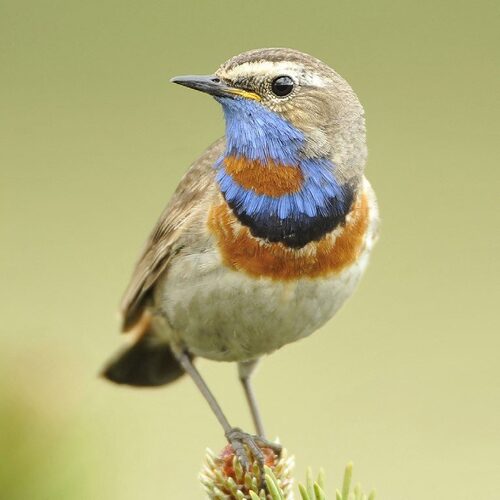
Materna J., Březina S., Harčarik J., Kukačka L., Hrázský Z., Čejková A., Šťastná P., Krause D. & Josefovičová A.: Uncertain Future of the Krkonoše/Giant Mts. Tundra
Not even the Krkonoše/Giant Mts. highest ridges or topmost summits, also called the Arctic-alpine tundra provide sufficient protection against human impacts. Climate change, eutrophication and local drivers, e.g. overtourism, biological invasions or insensitive building/construction interventions, combined with abandoning use of the landscape for centuries exploited by man resulted in irreversible changes in almost all Krkonoše/Giant Mts. vegetation types. Dwarf mountain pine (Pinus mugo) growths have been spreading at the expense of species-rich grasslands, highly adapted lichen tundra communities are overgrown by heath, sub-alpine grasslands not only on avalanche paths are replaced by dwarf mountain pine and bilberry (Vaccinium myrtillus) growths. The changes manifest themselves also in the rarest species populations requiring new approaches to their protection, conservation and management. Targeted small-size management measures on the key sites where priority species facing up to ultimate extinction occur can be a suitable consensual solution. The pilot intervention should be carried out, at the same time carefully monitoring all its impacts and gathering high-quality background information to assess the measures.
Koudelka M. & Lipták V.: The Za Hájovnou Cave and Other Surveys and Research
In the northern part of the Konice-Mladeč Devon (northern Moravia) there are not only well-known Javoříčko Caves and Mladečské Caves, both show caves, but also many others. The remarkable Za Hájovnou Cave is located on the foothills of Brablenec Hill, a part of the Paní Hory/Lady of Mountain Massif. It was formed in shelf-like grey limestones: in their bedrock there are phyllites of the Precambrian age. In 2000-2017 new spaces were found there, thus stimulating not only speleological activities but also extensive and intensive research which confirmed that there is one of sinks, in the past draining the Javoříčko Valley. Currently, the total length of discovered, i.e. dug out spaces has been more than 60 meters, and further important discoveries can be expected there. In addition, among other phenomena within the karst islet near the village of Javoříčko, particularly those discovered in the Brablenec Hill Massif, namely the V Habří Cave, U smrku Sink and the Majka Cave, the latter being a small fissure cave should be mentioned.
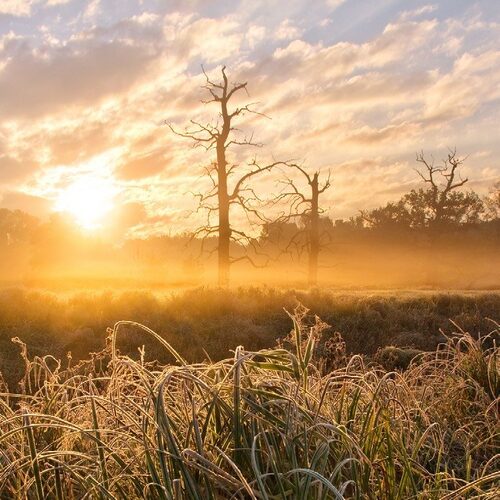
Pešout P. & Koukal S.: When the Soutok/ Morava and Dyje/Thaya Rivers Confluence Protected Landscape Area Will Be Declared?
In all expert analyses carried out during the past 30 years, the Podluží and Dyje/Thaya River Floodplain Area below the Nové Mlýny Waterworks (South Moravia) was classified as the highest priority for complementing the large-size Specially Protected Area network in the Czech Republic. In addition to including the area into the EU Natura 2000 network, its importance has been confirmed by declaring the Dolní Morava/Lower Morava UNESCO Biosphere Reserve in 2003, thus extending the Pálava/Pavlov Hills UNESCO Biosphere Reserve declared in 1986. Two Ramsar sites/Wetlands of International Importance stretch to the area and its significant parts are also protected by the appropriate cultural heritage legislation. Despite the national and international importance, only 2% of the extraordinarily significant landscape have been included into the Specially Protected Areas. Therefore, the Ministry of the Environment of the Czech Republic relevantly decided to make the effort to establish a Protected Landscape Area (PLA) there and to elaborate the appropriate background documents. The Nature Conservation Agency of the Czech Republic has prepared a new proposal delineating the Soutok/Morava and Dyje/Thaya Rivers Confluence PLA covering approx. 12,470 hectares to include the Sites of European Importance (pursuant to Act No. 114/1992 Gazette on Nature Conservation and Landscape Protection, as amended later, the term for Site of Community Importance, SCI under the European Union’s Habitats Directive) and to maximally respect the comments made by municipalities and other partners in the region. Management should be graded and phased according to zones while the strictest Zone I and II are proposed actually only on forest plots, floodplain meadows and natural water bodies.
Kaděra M. & Dedek P.: The Uncertain Future of the Giants from a South Moravian Floodplain
Particularly due to giant pedunculate oaks (Quercus robur) on floodplain meadows which provide the landscape on the confluence of the Morava and Dyje/Thaya Rivers (South Moravia) with romantic, almost fairy tale scenery/character, the idea of protecting nature across the whole extensive floodplain emerged in the early 20th century, nowadays having been performed by efforts to establish a Protected Landscape Area (PLA) there. Moreover, the PLA declaration is not sufficient to save the dying giants. The key issue for the future presence of such symbols of the Confluence is to restore water regime disturbed by water management measures on the Morava and Dyje/Thaya Rivers as well as targeted measures in forest growths of various age. It is hard to imagine the South Moravian floodplain without the oaks. They host a substantial proportion of insect species related to wood in various decaying stages. Despite of effort to at least partially enhance the water regime in the region it is necessary to implement measures in forest growths aiming at creating the next generation of “old-growth oaks”. The trees with a more massive trunk and a low crown have been selected and their vicinity has been making more open.
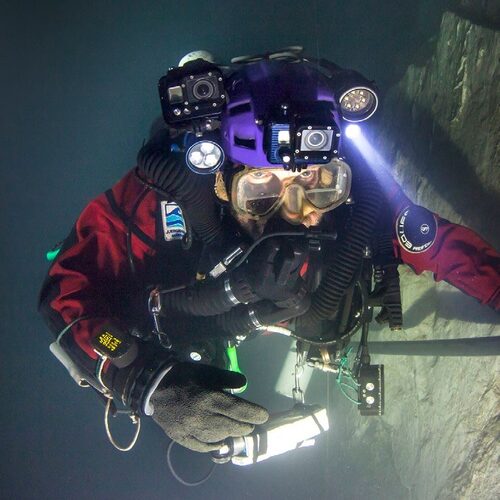
Šimečková B.: The Hranice Abyss and Depth Records
The Hranice Abyss is located near the town of Hranice (Central Moravia) within the Hůrka u Hranic National Nature Reserve established in 1952. It is a light hole and its open mouth is located at 315 meters a.s.l. with proportions of 104 × 34 meters and the depth of 69.5 meters. Lower spaces flooded by acidulous carbon dioxide mineral water display 15 – 22° degrees Celsius. The bottom of the Hranice Abyss has not been reached yet: the maximum depth measured has been 450 meter under the surface (2022). The abyss’ extreme depth is caused by the hydrothermal genesis, i.e. by a karst process shaping spaces bottom-up. It is the deepest abyss in the Czech Republic and it has also been the deepest flooded abyss in the world since 2016. The most recent climbing down made by ROV UNEXMIN GeoRobotic machine on 1 August, 2022 resulted, in addition to the depth record, in other ground-breaking outputs. Thanks to three built-in sonars it was for the first time exactly possible to show proportions, shapes and space orientation of the flooded space. Thus, the total depth of the abyss has reached 519 meters.
Hadincová V., Čížková Š., Volfová E. & Čuda J.: Will the Strapwort Survive in the Czech Republic the Year 2050?
The Strapwort (Corrigiola litoralis) is a specially protected, critically endangered species in the Czech Republic growing at the periodically emerging Elbe River sediments. The species has been disappearing from the landscape since the 19th century. The loss of the localities is due to construction of different barriers in the watercourse and consolidation of the riverbanks. Unless the rate of localities loss is stopped, the species would disappear from the landscape completely in the future. Although several studies on alluvial vegetation and strapwort’s fate have been in recent years done, we still miss ones on the species’ specific habitat requirements. That is why the authors carried out a survey of some localities and processed several experiments. They found how the species can survive unfavourable conditions, in which habitat it grows best and which species and under what conditions can threaten its survival.
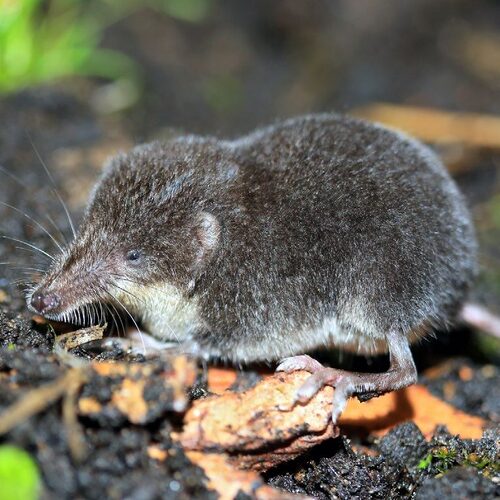
Hanzal V. & Anděra M.: The Mediterranean Water Shrew and Other Insectivores in the Czech Republic
Insectivores are the third most numerous group of recent mammals after rodents and bats consisting of almost 580 species: of them, more than 40 occur in Europe. African species were set out from the original order Insectivora, forming the separate order Afrosoricida. The remaining families, shrews (Soricidae), hedgehogs and moonrats (Erinaceidae), moles (Talpidae) and solenodons (Solenodontidae), are included into the new order Eulipotypohla. Its members live in a large part of the world except of South America and Australia and, of course, Antarctica. In the Czech Republic, members of three families, namely Soricidae, Erinaceidae and Talpidae, can be found. Due to a new discovery of the Greater white-toothed shrew (Crocidura russula), the insectivore fauna includes 11 species there. The current knowledge reveals that six of them occur quite generally, without clear subnational differences across the country. These are the Common shrew (Sorex araneus), Eurasian pygmy shrew (Sorex minutus), Eurasian water shrew (Neomys fodiens), Lesser white-toothed shrew (Crocidura suaveolens), European hedgehog (Erinaceus europaeus) and the European mole (Talpa europaea). The Mediterranean water shrew, also known as the Miller’s or Southern water shrew (Neomys milleri), Bicoloured white-toothed shrew (Crocidura leucodon) as well as the Greater white-toothed shrew expand their distribution range there. On the other hand, occurrence of the Northern white-breasted hedgehog (Erinaceus roumanicus) near the western border has been slightly retreating into midland. The authors conclude that at present there are no apparent factors/drivers substantially negatively affecting the extent of the occurrence or numbers in insectivores in the Czech Republic.
Ouhrabka V.: Karst Phenomena and Caves near the Town of Rokytnice nad Jizerou (Northern Bohemia)
Bodies of crystalline limestone to dolomites and erlans in vicinity of the town of Rokytnice nad Jizerou (northern Bohemia) are a part of the Krkonoše/Giant Mts. Karst built from carbonates of the Krkonoše/Giant Mts.-Jizera Mts. Crystalline Massif. Karst phenomena and some entrances into caves have had to be known since time immemorial. Moreover, only in the 1970s they were step-step recognised by the experts. In the early 1990s, speleologists from the Czech Speleological Society began to conduct intensive surveys within the area, which resulted in discovery of new parts of caves displaying rich cave speleothem decoration and remarkable hydrology of karst underground waters. Three main caves there, i.e. the Netopýří jeskyně/Bat Cave, Rokytnice Cave and the Ve Vilémově Cave being more than 50 meters long, are among the most important Krkonoše/Giant Mts. caves.

Hubený P.: The Šumava/Bohemian Forest Mts. Protected Landscape Area Celebrates 60 Years
It is almost unbelievable that the Šumava/Bohemian Forest Mts. Protected Landscape Area (PLA) has been celebrating sixty years in 2023. Nature conservation has been successful across such a large area: almost the total original PLA’s territory became National Park while in the rest of the area some dozens of small-size Specially Protected Areas were established. Nature is dynamic. Forests have been naturally regenerating more often and more trees survive after each logging: both species and age diversity have been increasing in forests there. Pollution of sulphur dioxide and lead has been terminated and soil and water acidification were stopped. Thus, forests have been apparently reviving there. In addition, forest coverage increased in the Šumava/Bohemian Forest Mts., partly thanks to planting, but mostly by woody plant tree self-seeding on abandoned and set-aside fallow agricultural land. Due to spreading the forest some plant species of cultural treeless habitats retreated, e.g. dwarf gentians (Gentianella spp.) or the Burnt orchid (Neotinea ustulata). Nevertheless, most of plant species survived and their conservation is implemented through regular management. After building the Vltava River Cascade, no Atlantic salmon (Salmo salar) has reached the Šumava/Bohemian Forest Mts. since 1950. On the other hand, the Eurasian lynx (Lynx lynx) was successfully re-introduced within the area and the Eurasian elk, in North America known as moose (Alces alces), Grey wolf (Canis lupus) and the Eurasian beaver (Castor fiber) spontaneously arrived there. Similarly, the area was repopulated by the Common raven (Corvus corax) or the Common crane (Grus grus). The PLA Administration successfully reintroduced the Ural owl (Strix uralensis) and it has been maintaining a viable population of the Freshwater pearl mussel (Margaritifera margaritifera) or the Western capercaillie (Tetrao urogallus). Despite strong decrease in numbers a Northern black grouse (Lyrurus tetrix) population has been surviving there. Large-size nature conservation and landscape protection has met their targets and goals. Despite various nature degradation and locally strong expansion of built-up areas the overwhelming part of the PLA has been under effective conservation. It would be nice if we maintain such a trend and to offer to our descendants, in addition to large wilderness areas also the landscape with all the values having been saved for sixty years: with beautiful nature, magical historic landscape scenery/character and with all native species.
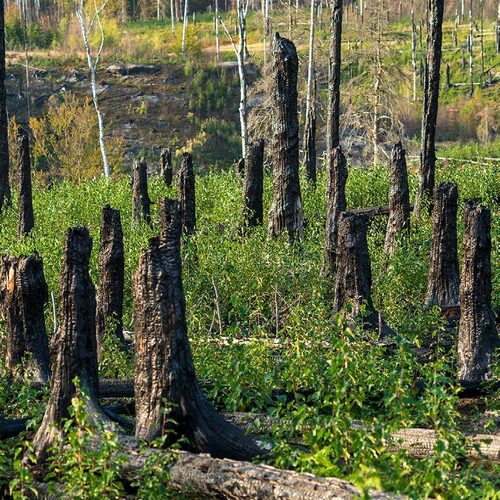
Härtel H., Vébrová D., Šafránek J., Sojka V. & Blažej L.: Development of an Area after the Fire in the České Švýcarsko/Bohemian Switzerland National Park
Within a fire area in the České Švýcarsko/Bohemian Switzerland National Park (northern Bohemia) where a fire occurred in 2022, spontaneous restoration in nature has been monitored. The extensive fire affected the western NP’s part in 2022 covering more than 10 square kilometres: it partially exceeded into the neighbouring Sächsische Schweiz/Saxon Switzerland National Park in Germany. Primary knowledge shows that the fire area has been very heterogeneous which has also been reflected into development since the fire. Succession has been in the initial stage characterized by some pyrophilous fungi and mosses: a vigorous arrival of birch has also been found there. Of invasive alien species it has not been clear yet how the Eastern white pine, also known as the Weymouth pine (Pinus strobus) common in other parts of the NP will express itself there: the same is the case of the very successful anemogamous American burnweed (Erechtites hieraciifolius). During one of many projects both positive and negative impacts of the fire on biological diversity of plants, fungi, hexapods, birds and bats have been monitored, separate research aims at insects. Research on vegetation regeneration in three forest types is also of fundamental importance. Research and documentation has also been dealing with abiotic nature in which some changes caused by great natural disasters, e.g. surface layer flaking or spalling in sandstones or rock block fissuring, are often irreversible.
Nature and Landscape Management
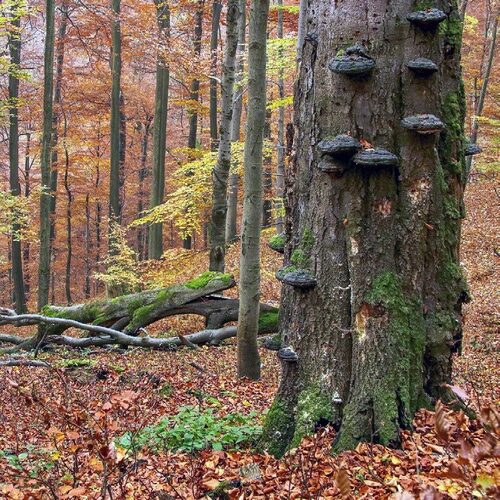
Popelář P. & Myslikovjan T.: Forests – the Greatest Wealth of the Beskydy/Beskids Mts.
Fifty years is an enough long time to recognize transformation even in the so stable environment as the forest. Forests in the Beskydy/Beskids Mts. Protected Landscape Area (north-eastern Moravia, Moravian-Silesian Region) had not been influenced by cutting for long centuries. Only Wallachian colonization and settlement running clear-cutting forest management from the 15th to 17th century followed by moving people from valleys to ranges introduced using mountain sites by humans. Continuous forests grazed by sheep with mostly deforested mountain ranges had been in the course of time formed and forests were step-by-step reduced in some places only to 20-30 % of their original cover. After involuntary shepherding run-down and prohibition of grazing in forests, abandoned pastures were reforested. The radical transformation of mostly fir-beech growths in the Beskydy/Beskids Mts. into stands with high Norway spruce (Picea abies) proportion continued during almost the whole 20th century. The clear-cutting management with artificial regeneration preferring Norway spruces definitely dominated there. Since 1945, further loss of agricultural land has been continuing in some waves, due to its afforestation/deforestation or overgrowing in the course of natural succession.
At present there are 42 small-size Specially Protected Areas in the Beskydy/Beskids Mts. forest, most of them being state-owned. Moreover, there also is a significant proportion of church-owned forests there. In addition, the Nature Conservation Agency of the Czech Republic has been trying to purchase private forests where many valuable growths have been preserved. Particularly for bird habitats protection and conservation, 810 hectares of forests have been left to spontaneous development outside reserves and at least 5,000 trees have been left to decay based on accepted compensation paid for economic loss. In addition, for thousands of trees owners do not require such compensations. In the Beskydy/Beskids Mts., there has been the same and unchanged task for the State Nature Conservancy: to try to maintain and enlarge forest areas minimally impacted by humans and to support close-to-nature forest management in areas as large as possible
Bartošová D. & Tomášek V.: Some Rare Wild Animal Species in the Beskydy/Beskids Mts. Protected Landscape Area in the Course of Time
In the Beskydy/Beskids Mts. Protected Landscape Area (PLA) early years, species protection had targeted particularly large and conspicuous species, e.g. the Eurasian lynx (Lynx lynx), Grey wolf (Canis lupus), Brown bear (Ursus arctos) or the Western capercaillie (Tetrao urogallus). Huge efforts had been paid to protection and conservation of amphibians and their habitats in this part of north-eastern Moravia. At that time, temporal and technological possibilities to gather the data on wild animals were limited and data were obtained rather occasionally. Only later, thanks to new possibilities, monitoring aimed at other rare and endangered species not so conspicuous and attractive for the general public but being important both for forest and non-forest ecosystems. After establishing the Natura 2000 network related to joining the European Union the Beskydy/Beskids Mts. PLA was declared as Site of European Importance (pursuant to Act No. 114/1992 Gazette on Nature Conservation and Landscape Protection, as amended later, the term for Site of Community Importance, SCI under the European Union’s Habitats Directive). In addition, there are two Bird Areas (pursuant to the above act, the term for Special Protection Area, SPA under the EU Birds Directive) there. Large carnivores are one of the nature conservation subjects there: when applying criteria for favourable conservation status in the habitat and respective species, the most suitable conditions are for grey wolves there, relatively favourable for Eurasian lynxes and least favourable for brown bears. The Eurasian otter (Lutra lutra) is another specially protected carnivore inhabiting the Beskydy/Beskids Mts. and it is encouraging that camera traps have recently evidenced rare occurrence of the European wild cat (Felis silvestris) within the PLA. There have been efforts to reintroduce western capercaillies. At present rare bird species living in the Beskydy/Beskids Mts. include the White-backed Woodpecker (Dendrocopos leucotos), Ural owl (Strix uralensis), Eurasian three-toed woodpecker (Picoides tridactylus) and the Red-breasted flycatcher (Ficedula parva).
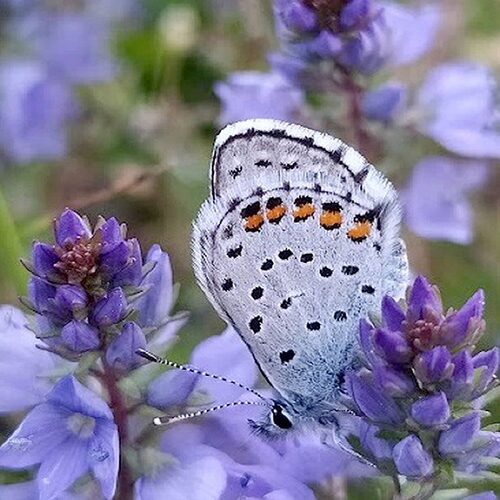
Skála P., Andres M. & Sedláček O.: A Ray of Hope for the Eastern Baton Blue (Pseudophilotes vicrama)?
Sharp weather oscillations/fluctuations have recently negatively affected many insect species including butterflies. The most affected ones include not only summer xerothermic species habitats of which change into an inhospitable desert without nectar and host plants during their flight period, but rather surprisingly also some species with spring activities. The latter are for a change decimated by unprecedentedly cold and rainy weather during their flight period which has been becoming a norm as well as a summer drought. They also include the Eastern baton blue (Pseudophilotes vicrama) which can illustratively demonstrate the situation caused by weather extremes. It is the species with specific habitat requirements preferring dry extensive pastures with rich occurrence of early flowering thymes (Thymus spp.). Moreover, even before arrival of the weather extremes, the butterfly was endangered (Farkač et al. 2005). In the current national Red List (Hejda et al. 2017) the species is listed even as Critically Endangered because it became extinct in Moravia as early as about the year 2000 and has been surviving in Bohemia only on the Capital City of Prague’s territory and in the České středohoří/Central Bohemia Uplands. Therefore, based on detailed research an action plan/recovery programme for the species has been launched. At present, the Eastern baton blue is among the most endangered butterfly species in the Czech Republic since it is threatened by decline in and loss of high-quality extensive lower elevation pastures as well as by climate change. Artificial keeping and breeding provide nowadays a real possibility to recover some extinct populations at sites where thanks to well-done grazing management thyme steppes have been coming back.
Martínek L.: The Nature Conservation Agency of the Czech Republic’s Project Scheme in the Operational Programme Environment 2021–2027
In the end of 2022, the Operational Programme Environment’s (OPE) new calls appeared within the Nature Conservation Agency of the Czech Republic’s (NCA CR) project scheme. The common denominator is the so-called Simplified Methods of Proving (SMP) to be applied in projects with total costs of less than EUR 200,000. The key benefits include a simply (on-line) submission of an application, reduced number of documents to be enclosed, a quick assessment and a payment of a subvention. The amount of money is derived from standardized costs of usual measures set by the Ministry of the Environment of the Czech Republic. The NCA CR shall newly become a subvention provider. The total amount available for the NCA CR’s project scheme for implementing projects by the SMP is CZK 3.15 billion (EUR 135 million). The NCA CR has currently launched two calls for proposals for the specific targets No. 1.3 and 1.6., the separate call for plans and studies has also be considered. The whole procedure is described in a guide issued by the NC ACR, all the information is available at https://nature.cz/web/dotace/opzp-v-prs-aopk-cr. The article also presents stories of successful projects from the last OPE’s programme period, i.e. 2014-2020.
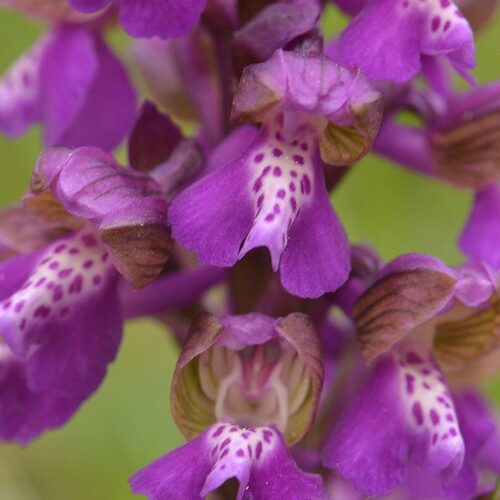
Vlačiha V.: Support to a Green-winged Orchid (Anacamptis morio) Population in the České středohoří/Central Bohemia Uplands
The České středohoří/Central Bohemia Uplands is well-known due to its high diversity in nature, namely rich variability in the volcanic landscape, climate condition variability, complicated development caused by human activities and last but not least its relatively extensive size. High biological diversity does not imply that the area is fully stable with no problems related particularly to high level of threat posed to some wild plant and animal communities and whole ecosystems. Action Plans/Recovery Programmes aiming at the Eastern pasquflower (Pulsatilla patens), Ladybells (Adenophora liliifolia), Autumn dwarf gentian (Gentianella amarella), Bohemina sand pink (Gentianella amarella) and European ground squirrel (Spermophilus citellus) are implemented there. Sub-national Action Plans, e.g. for the European beaver (Castor fiber), Hermit (Chazara briseis), European green lizard (Lacerta viridis) and the selected blue butterfly species are another species protection/conservation tool in the České středohoří/Central Bohemia Uplands. In 2021, a study for supporting a Green-winged orchid (Anacamptis morio) population which had occurred at almost 50 sites there was prepared. Moreover, in 1945 – 2000 almost all the sites ceased to exist and only the Bohyňská lada Nature Reserve seemed to be promising. Therefore, the orchid population has carefully been managed there also including planting young individuals from seeds and their planned reintroduction to the original site.
Plesník J.: Current and Future Trends in Nature Conservation and Landscape Protection
In addition to traditional nature conservation tools, e.g. protected area networks, species protection/conservation, international cooperation, bioinformatics, monitoring and sustainable use of biological resources, a special attention has been paid in biodiversity conservation and sustainable use to some issues since 2005. The main paradigms include ecosystem/ecological integrity and ecosystem services concept, latter having more recently been elaborated into nature’s contributions to people idea. “New” non-equilibrium paradigm highlighting a high dynamics of ecosystems, and ecosystem approach have been applied in ecosystem management which should be adaptive to adequately and in time react on changes in nature and the landscape. Extensive and at the same time really rapid development in genetics, particularly molecular one, resulted in synthetic biology sensu scricto, molecular ecology, gene/genome editing and species de-extinction which all affect and shall be even more in the future affecting biodiversity conservation and sustainable use of its components. Mainstreaming biodiversity into various sectors, ensuring that biodiversity, and the services it provides, are appropriately and adequately factored into policies and practices that rely and have an impact on it, as well as participatory approach in nature management both in protected areas and outside them are also important. It can be supposed that new emerging issues in biodiversity conservation shall appear, too.
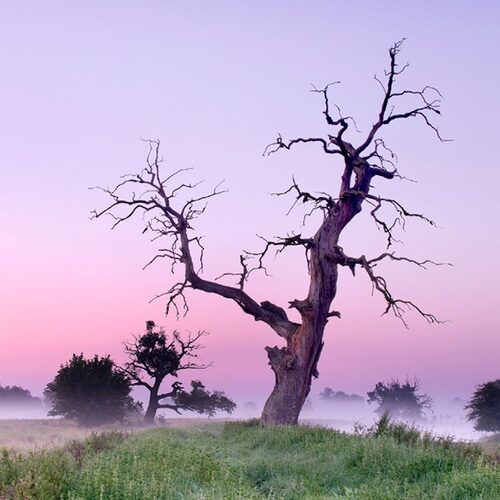
Riedl V., Horal D. & Dedek P.: Changes in Forest Management on the Soutok/ Morava and Dyje/Thaya Rivers Confluence
Floodplain forests on the Morava and Dyje/Thaya Rivers confluence (South Moravia) cover 54% of two Sites of European Importance (pursuant to Act No. 114/1992 Gazette on Nature Conservation and Landscape Protection, as amended later, the term for Site of Community Importance, SCI under the European Union’s Habitats Directive), namely the Soutok/Confluence and Podluží Area Floodplain and the Niva Dyje/Thaya River Floodplain covering in total approx. 7,000 hectares. A forest growth in felling area with high proportion of the Pedunculate oak (Quercus robur) where due to natural processes in tree ageing, characteristic microhabitats appear can generally be considered a biologically valuable hard-wood floodplain forest habitat. Based on higher species richness, in total 178 hectares of forest growth were delineated where the forest should become sparse (up to final crop density of 0.5 – 0.7). In addition growths to be shifted into an intermediate forest type covering approx. 60 hectares were also selected. On further 548 hectares, felling has been delayed at least ten years and on 202 hectares forest growths were left to spontaneous development. Thanks to the above measures the most valuable forest stands have not been felled. After signing the agreement between the Nature Conservation Agency of the Czech Republic and the Forests of the Czech Republic, State Enterprise, in October 2020 principles even more reflecting biological values of the area were incorporated into new Forest Management Plans (FMPs). In growths with the higher oak proportion (50 – 100%) a step-by-step regeneration with some phases of making the growth less dense in fifteen-year intervals (40% – 30% – 20% – 10% + reserved trees to be left there) should take place. In total, 700 hectares should be regenerated step-by-step by four fellings during 30 years of the regeneration. In addition more intensive measures in growths from 20 – 60 years of age within the area of 85 hectares were also incorporated in the FMPs: in the future the oaks with more space shall form a high-quality skeleton of the growth.
Veselý D.: Restoration of Flow Branches on the Dyje/Thaya River
The Dyje/Thaya River with the Morava River is surrounded by the most extensive and ecologically most valuable system of floodplains in Central Europe. By straitening in the 1970s and 1980s the Dyje/Thaya River had been made shorter by 3.2 kilometres. At the same time dikes preventing flooding had been built on both sides along the state border stretch on the Dyje/Thaya River. These measurement should both stabilize the border between Czechoslovakia and Austria and provide flood prevention/control. The whole border stretch being 16.5 kilometres long was for a long time closed by the Iron Curtain. After the above water management measures, there were more than 20 remnants of the original river bed left: these are backwater river branches/arms of various character. Moreover since that time all the fragments have been silted, thus developing themselves towards a rapid termination. The modified river bed caused by puncturing the branches displayed low morphological value and straitening the watercourse contributed to accelerating water outflow from the landscape there. From a point of view of climate change adaptation it was favourable. Therefore the watercourse management authority decided to restore the patterns. Former river branches/arms are step-by-step connected the river, both on the Austrian and Czech Republic’s territory. Connecting the former backwater branches/arms is one of the important elements in a new approach to the Dyje/Thaya River management along the state border stretch agreed by water management authorities on both sides of the frontier. The project takes into account other spontaneous morphological development in the river. Some spring floods created morphological structures which had been previously missing there. Gravel bars or rotation of depths and shallows at fords newly provide the character of the lowland river.

Bernard O.: The Great Castle Fishpond Restoration
The Great Castle Fishpond located in the Lednice Castle Park (South Moravia) has been part of landscaping north of the Lednice Castle for many dozens or rather hundreds of years. One of the preserved plans is e.g. a project attributed to Bernard Petri in about 1805. The fishpond with 16 islands was created instead of original wetlands: on current islands there are breeding colonies of the Grey heron (Ardea cinerea), Black-crowned night heron (Nycticorax nycticorax), White stork (Ciconia ciconia), Great cormorant (Phalacrocorax carbo) and other water birds. Specially protected mammal species, e.g. the Eurasian otter (Lutra lutra) and, of course, the Eurasian beaver (Castor fiber), as well as many specially protected amphibians, insects or other invertebrates also occur there. At present, the main aim of the National Heritage Institute was to restore damaged banks by their reinforcement, to complement them to their original size and to preserve or increase woody plant species richness, taking into account current climate change. The project includes removing part of sediments from the castle fishponds’ flooded area, reinforcement of the original bank edge and finishing building banks. In addition littoral habitats were built at selected sites within the fishpond’s flooded area and artificial islands were restored there. Birds habituated soon themselves to movement of machinery and did not consider it as a threat. After draining the fishpond banks were reinforced following the project’s documents. For entry of heavy machinery into the flooded area, exit ramps from rubble were built. Sites for movement of excavators and caterpillar tracks distributing aggregate across the fishpond’s bottom were reinforced and protected by metal prefabricates. Therefore, bank woody plant roots were not damaged. It is encouraging that solutions acceptable by both heritage preservation and nature conservation have been found there.
Havira M. & Servus M.: European Spruce Bark Beetle Plague in the Jeseníky Mts. Protected Landscape Area – A Story (Most Probably) Has Not Finished Yet
According to experts the current European spruce bark beetle (Ips typographus) plague is unprecedentedly the greatest in the Czech Republic’s history: it avoids neither the Jeseníky Mts. Protected Landscape Area (northern Moravia). It is caused mainly by extreme weather events, namely by droughts, uneven rainfall distribution throughout the year and above-average warm weather accelerating the bark beetle development (ontogenesis). Forest growths consist by the Norway spruce (Picea abies) in 75% there. Moreover, according to natural tree species composition the proportion should not exceed 30%. Despite many objections by some NGOs the appropriate spatial exemptions were issued for Zone I and II within the Jeseníky Mts. PLA. Thus trees infected by bark beetle could be processed although clearings large than a hectare were caused there. One of the conditions included in the exemptions was to leave at least 30 cubic meters of wood to be decayed per hectare. Since 2017 felling due to the bark beetle plague has affected approx. 3,000 hectares of forest, i.e. about 5 % of the total forest coverage there. It is clear that in the Jeseníky Mts. PLA the bark beetle plague is accumulated particularly in Zone III where 63% of the total forest coverage is located. On places where felling was carried out in 2017 – 2022 the European beech (Fagus sylvatica) and other woody plants, e.g. the Sycamore (Acer pseudoplatanus), birch (Betula spp.), Rowan or Mountain-ash (Sorbus aucuparia), European silver fir (Abies alba) or the European larch (Larix decidua) in total reached approx. 65%, while only 18 % of the area was reforested by the Norway spruce which in addition has occupied other 17% due to natural regeneration. Thus, the current tree species composition is more favourable than before the bark beetle plague. In addition, the exemptions issued allowed applying graduate measurements within National Nature Reserves, but not because of their protection itself but because of protection of adjacent commercial stands. Despite moderate optimism the authors conclude that also in the future weather shall be the crucial factor for bark beetle development, particularly the rainfall volume and temperature dynamics.
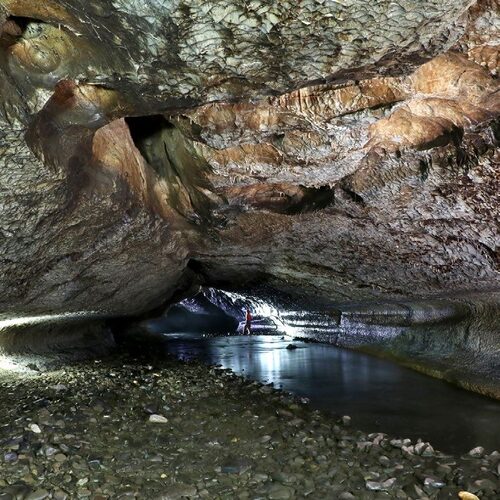
Foller J. & Kotyzová M.: Sewage Water Treatment in Karst Areas
Karst areas are sensitive to underground water pollution. Polluted water infiltration into karst underground spaces can be significantly reduced by grassing arable land, particularly above caves and around sinkholes where risk possessed by leakages of water containing fertilizers and pesticides is the highest. Moreover the quality of surface watercourses entering protected karst areas and of waters coming by drains from non-karst vicinity can under the current legislation be influenced only hardly. In the Czech Republic, there are no buffer zones in Protected Landscape Areas and their administrations have no power outside the PLAs. It is clear that PLAs are significant for the landscape and biota on surface but we should protect water ecosystems not only within Specially Protected Areas but also outside their borders across the whole source areas. This is the only way how to avoid karst water pollution and to protect the unique habitats there. The Moravský kras/Moravian Karst PLA Administration (South Moravia) commissioned a study dealing with the topic and funded by the national Landscape Natural Function Restoration Programme. The only suitable way to treat sewage water from municipalities in karst areas are mechanic-biological waste water treatment plants (WWTPs), sewage sewers should be separated and small or vegetation WWTPs are not suitable for that purpose. The article is followed by the information on how sewage water is handled in the Český kras/Bohemian Karst PLA (Central Bohemia).
Brus J.: Mosquito Management in the Litovelské Pomoraví/Litovel Morava River Basin Protected Landscape Area
Wetlands are among the most important and at the same time also globally the most threatened ecosystems. They contribute to the natural water cycle, retain water in the landscape, positively influence the climate by great evaporation, capture redundant carbon dioxide from the atmosphere and provide many specially protected and significant fish, bird and invertebrate species with suitable habitats. They protect the landscape against floods and last, but not least, are important biodiversity hotspots. The Litovelské Pomoraví/Litovel Morava River Basin Protected Landscape Area (Central Moravia) with naturally meandering Morava River was declared as Wetland of International Importance/Ramsar Site under the Ramsar Convention. Numerous mosquito populations are an integral part of the PLA’s floodplain forests there. Due to a lot of municipalities and inhabitants living in the PLA’s vicinity there are mosquito plagues treated by necessary sanitary and hygienic measures. Therefore, there is a pressure to apply uniformly insecticides against mosquito larvae. Vectobac is among the most often applied ones: it contain bacterium Bacillus thuringiensis israelensis (Bti) causing 90 to 100% mortality in larvae of the targeted organisms while direct impacts on other water and terrestrial organisms are generally limited or none. Nevertheless, it is necessary to precisely dose the substance taking into account water parameters and the specificities of the given area. The MOSPREMA project will newly help to identify sites with high accumulation of mosquito larvae and to decide whether applying the insecticide in pools is needed due to risk of the mosquito plague. Information gathered by monitoring is immediately after measurements having been taken in the field recorded on a server and consequently visualized as a map application. The data obtained will help, together with those on real emergence of larvae, distribution and density in mosquito eggs, to develop a model predicting the mosquito population dynamics. Thus, the targeted interventions against mosquitos allow minimizing the adverse effects.
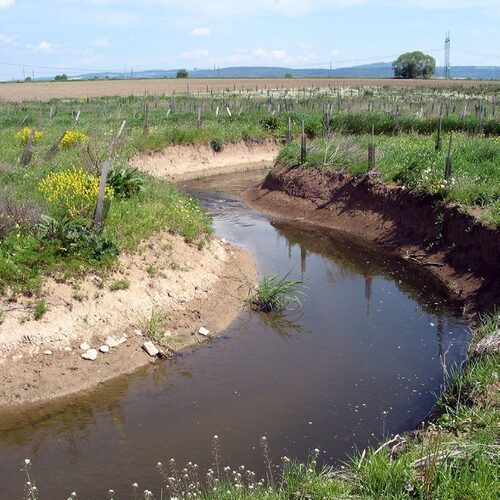
Just T.: Hydromorphological Activities of Eurasian Beavers in Žichlínek Flood Water Reservoir and Their Assessment Using Costs of Usual Measures Standards
In 2006 – 2008 the Žichlínek Dry Flood Water Reservoir near the town of Náchod (East Bohemia) was built financed from the Morava River Basin Management Authority, State Enterprise. It is the biggest premise of this type in the Czech Republic, which should significantly contribute to flood control in basins of the Moravská Sázava/Moravian Sazava and Morava Rivers. The water reservoir was created by partitioning the Moravská Sázava/Moravian Sazava River by a ground dyke reaching the length of 1.6 kilometre and the height of 7.6 meters above the terrain. The submerged area covers 166 hectares. As early as in 2009, the Nature Conservation Agency of the Czech Republic (NCA CR) staff (Moravec, Just) had found in the Žichlínek Flood Water Reservoir first browsings of willows caused by the Eurasian beaver (Castor fiber). Later, the Lukovický potok/Luková Brook watercourse was dammed by a beaver dam with a crest reaching the adjacent terrain level: water level was swelling there. Spilling the brook water particularly on the right-sided floodplain created extensive marshes and naturally authentic lateral watercourse beds begun to be formed there. Due to beavers’ activities in the Žichlínek Flood Water Reservoir, water conditions in the submerged area have been significantly enhanced. Using the Costs of Usual measures Standards applied in the environmental protection sector in the Czech Republic, restoration outputs made by beavers should be estimated at CZK 11.34 million (EUR 467,000). Therefore, assessing beavers’ activities can be a useful tool in similar cases.
Štěpánek P.: Saving the Crucian Carp
Older anglers or children playing in water in flooded quarries and forest pools can remember a smaller fish resembling the Common carp (Cyprinus carpio). It was common and numerous, anglers used its dwarf morph as a hookbait in angling predatory fish. Moreover, the Crucian carp (Carassius carassius) has been rapidly disappearing from the wild in the Czech Republic. The main drivers of the decline include loss of smaller waterbodies, forest pools or oxbow lakes where the species was among the prominent fishes. It was pushed out from most of the commercial fishponds by the Common carp keeping there. Another disaster for the Crucian carp was an introduction of its eastern relative, the Prussian carp (Carassius gibelio) in the 2nd half of the 20th century, which can totally replace the native species. The Prague Zoological Garden in collaboration with Prague anglers from the Czech Anglers Union, Biology Centre of the Academy of Sciences of the Czech Republic České Budějovice/Budweis and Plzeň/Pilsen Zoological Garden have developed an action plan to save the remarkable fish. For the Crucian carp’s recovery in the Czech Republic, particularly restoration of its preferred traditional habitats is needed. These include oxbow lakes and tools along rivers and in forests, wetlands following up on fishponds and other artificial waterbodies, but also flooded drains, old raceways, flooded quarries and other flooded underground workings. Fishermen can help by increasing species richness in commercial fishpond stocks and communication with, education of and raising awareness among the general public are also crucial.

Šálek M.: Farms: Bird Diversity Islands under Threat
In the intensively used agricultural farmland with lack of natural or semi-natural landscape elements farms can become islands of bird species diversity. For some bird species they are a key habitat for their survival. The highest numbers and species diversity in bird populations and communities in active farms particularly aiming at husbandry/livestock production are amplified by food availability in the course of the year, e.g. through manure heaps, silos or seed stock stores. Another reason of the attractiveness of farms for birds can be crop diversity in the adjacent farmland. The conservation potential for birds can be significantly reduced by two processes – on the one hand by land abandonment and finishing livestock breeding, on the other hand, by farm modernisation. The latter fundamentally affected the bird fauna as evidenced by research on the Barn swallow (Hirundo rustica), Western house martin (Delichon urbicum) or the House sparrow (Passer domesticus). The pattern can be explained by two main factors, namely (i) limited nest-site availability; (ii) limited food resources. If we want to halt or at least slow down the decline in farmland birds it is absolutely necessary to pay attention to these habitats.
Tichý L., Vítovcová K., Řehounková K., Preislerová Z., Novák P., Pánková H., Štochlová T. & Přibylová A.: Method on Seed Stock Collecting for Sub-national Grass-Seed Mixtures
In the Czech Republic, changes in agricultural land ownership in the 1990s had resulted in decline in agricultural production: arable land often was changed into meadows and pastures. Species-low grass-seed mixtures with unsuitable composition were and still have been used for grassing over. Thus, extensive grassland areas were established where only a few of grass species dominate and broad-leaved herbs are represented only by common species spontaneously entering there from the adjacent areas. Such grasslands do not provide insects with sufficient food availability and are a barrier for spreading of suitable species, similarly to extensive fields or forests. For restoring the grasslands when using sub-national grass-seed mixtures sufficiency of suitable seed stocks is crucial. At the beginning their collecting had been carried out manually, which is very arduous and expensive.
The article compares testing various types of harvesting machines based mostly on the principle of a quickly rotating brush combing out ripened seeds from a vegetation growth and provides basic characteristics of the individual machines. At four study plots the success rate of germinability in the material harvested is also compared: it was found that for the germination capacity of seeds it is crucial to prepare a site before sowing and suitable management after it. Based on the up-to-date experience none of the machines tested has principally negative impact on insects.
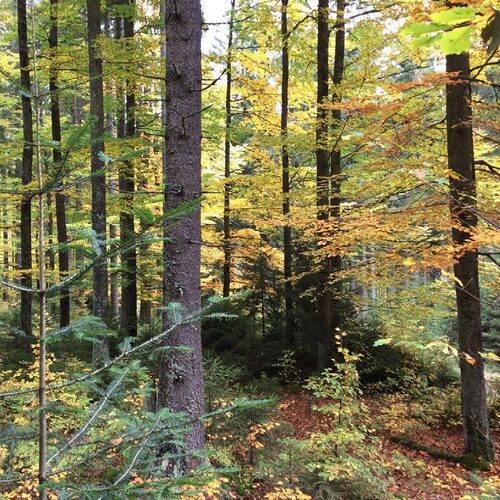
Kozel J.: Game Management in the Šumava/Bohemian Forest Mts. National Park
Since establishing the Šumava/Bohemian Forest Mts. National Park in 1991 game and its management have been an important part of forest management there. The first NP’s Management Plan (Kučera, Pecharová et al. 1992) dealt extensively with the issue, Red deer (Cervus elaphus) numbers were extremely high within the whole NP and keeping and breeding of trophy game was preferred. Moreover it was clear at that time that due to red deer’s migratory behaviour its management should not be limited only to the NP’s territory but it should be connected with that on the whole Protected Landscape Area’s territory as well as with the whole Šumava/Bohemian Forest Mts. foothills including the Bavarian side. The red deer’s maximum harvest in the NP’s history was reported in 2017 where 1,156 red deer was bagged. Since that time the red deer’s harvest has been declining, i.a. due to NP and Bayerische Wald/Bavarian Forest National Park’s long-term targets as well to the Grey wolf’s (Canis lupus) comeback. In the game management strategy having been under preparation it is necessary to take into account that if game management in the NP should be effective the same approach as within the most NP’s territory during the past 30 years should be applied. In addition it is also important to timely and adequately respond to new conditions including unifying the approach across the whole Šumava/Bohemian Forest Mts. despite any borders.
Research, Surveys and Data Management
Nepraš K., Filipová L. & Beran V.: Impacts of Game Overpopulation on Non-forest Ecosystems in the Elbe River Valley
Game overpopulation impacts on non-forest ecosystems has been until recently of peripheral interest and thus marginalized by nature conservation. Moreover, it has been becoming clear that game can be an important factor/driver threatening rock steppe habitats, rare wild plant species growing there and consecutively other groups/taxa. The risk is increasing in synergy with other negative circumstances, e.g. extreme drought periods, natural vulnerability of isolated populations or biological invasions. The article presents, using three model sites on rock steppes in the Elbe River Valley how game causes strong disturbances in grassland vegetation and eutrophication of the environment and supports soil erosion. Total herb layer cover declines, dominant species in vegetation change and decline in species of the Festuco-Brometea class occurs. At the sites available species being able to profit from changes in environmental conditions (e.g. Artemisia absinthium, Cynoglossum officinale, Echium vulgare, Isatis tinctoria, Sisymbrium loeselii, etc.) expand. Species diversity significantly decreases there. Rare species with restricted populations are threatened with extinction caused just by grazing down or by consequences of environmental changes, e,g. bare soil vulnerable to erosion can result in loss of a seed bank of the species occurring there. Nutrient input can disturb mycorrhizal relations, etc. Extreme drought periods can in some extent also negatively affect vegetation but game negative impacts are for local vegetation development absolutely decisive.
Vild O., Veselý O. & Chobot K.: How Can Databases Profit from Plant Identification Based on Machine Learning/Artificial Intelligence?
Analysing pictures by deep neural networks has been step-by-step moving from scientific/expert conferences to everyday life. Its application also includes identification of plants from photos. The applications work simply: a photo of the given plant is taken by a smartphone and in a few minutes you receive the name of the plant. The application Plant.id developed by FlowerChecker, a company based in Brno is one of the most successful. The technology can also be used for identification of series of photos or their databases. The results of comparing plant identification from records made by the authors of the findings and that made by computer applications show that technology recognizing and identifying plants from photos can make easier a review of records in more extensive databases, e.g. the Nature Conservancy Species Occurrence Finding Data Database. Therefore, the Nature Conservation Agency of the Czech Republic has been considering to include the above application into the BioLog one used for citizen science in the Czech Republic.
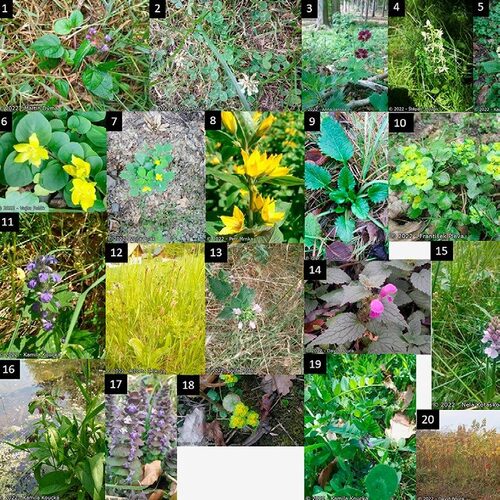
Čech M. & Čech P.: The Importance of Permanent Nest Walls for the Common Kingfisher
The Common kingfisher (Alcedo atthis) is an avian species protected by both Czech and European Union law. In the Red List of Threatened Species of the Czech Republic it is classified as a vulnerable species. Kingfisher nests in steep bank walls in meanders of streams, rivers and even water reservoirs. The frequency of occurrence of these highly specific nest sites is rather low within the Czech Republic’s landscape, thus limiting the population, in case of channelized streams and rivers, opencast mine lakes, fishponds and most other artificial impoundments they are absent at all. In a unique situation of high occurrence of appropriate nest sites (e.g. the Slapy Water Reservoir, Botič Brook, Dyje/Thaya River), the strict territoriality of kingfisher plays a crucial role. The quality and safety of kingfisher nests composed of deep hole finished by a coconut like chamber is approved by both predators and flood events. Kingfishers highly select for permanent nest walls (by 82 %, compared to newly formatted), which can be used for successful nesting and repetitive chick rearing even for decades. These permanent nest walls (sites), being of crucial importance for the kingfisher population, have to be strictly protected.
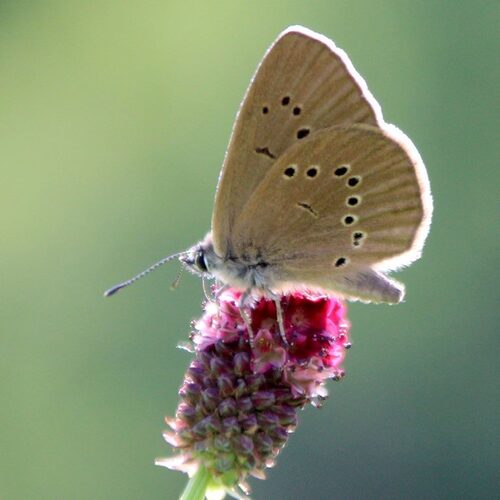
Krása A.: The Dusky Large Blue (Phengaris nausithous) in the Moravský kras/Moravian Karst
The Dusky large blue (Phengaris nausithous) is among butterflies with the most interesting life history strategy which includes feeding caterpillars by ants in their nests. Moreover, the strategy at the same time increases its sensitivity to management of sites where it occurs. In the Moravský kras/Moravian Karst (South Moravia) and its close vicinity the butterfly has been living but its records had been only sporadic in the past. Moreover, a detailed survey showed that the state of affairs has been completely different and considerably better. In total, dusky large blues have been newly found or refound at approx. 30 sites. During the survey, the Dusky large blue was reported from most areas in the Moravský kras/Moravian Karst and its close vicinity where the Great burnet (Sanguisorba officinalis) grows. Nevertheless, the author supposes that new sites inhabited by the butterfly shall be found in the future. Thus, the conservation status of the species seems to be quite promising because threats to the butterfly are successfully revealed and they are consequently handled in cooperation with the relevant land managers.
Hromas J.: A Remarkable Discovery (Not Only) For the Na Špičáku Cave
The oldest written notes on caves in the Czech Republic’s territory are shrouded in many mysteries. Moreover, the first trustworthy text deals with the Na Špičáku Cave (northern Moravia). It comes from one of many so-called Old Italian books, i.e. manuscripts intended for medieval prospectors seeking for sources of precious metals and minerals. The report is a part of one of the oldest Italian books called Wegweiser zu den Bergwerken in der Oberlausitz und in Schlesien (Guidepost to mines in Upper Lusatia and Silesia) supposedly written by some Antonius (Anton) Wale as early as in 1430: the manuscript had been kept as a part of bigger volume (convolute) in the Wroclav/Breslau Municipal Library under call number R454 until the World War II. After the war, the manuscript was put on a list of war losses: thus, only younger transcripts have been available. Moreover, Otto Štemberk and Pavel Zahradník, researchers from the town of Trutnov, discovered with a help from Ms Regina Cermann (Vienna) the lost original manuscript in the Berlin State Library in 2021. The Italian manuscript’s author Antonius Wale was born in 1395 and he was dealing with trade in Central and Eastern Europe for forty years, particularly in Wroclaw/Breslau and Krakow/Cracow, where he became, inter alia, an important entrepreneur in mining, namely salt one. The discovery of the lost Old Italian books provides an extraordinary contribution to knowledge of the oldest history of human settlement in the Lužické hory/Lusatian Mts., Jizerské hory/Jizera Mts., Krkonoše/Giant Mts. and Jeseníky Mts. including the Polish foothills and to revealing their mineral resources by first prospectors.

Jaška P., Vorel A., Šrutová J. & Hulva P.: On the Origin of Czech Wolves Using the Slavkovský les/Slavkov Foest Mts. As an Example
The Grey wolf (Canis lupus) occurrence has been reported from Slavkovský les/Slavkov Forest Mts. (West Bohemia) over the past few years. In the late summer 2022 information on presence of a pack emerged more often: the occurrence was confirmed by the Nature Conservation Agency of the Czech Republic (NCA CR) staff in Late September/early October 2022 thanks to camera traps and various signs (Jaška et al. 2022). The wolves’ arrival there raises just as somewhere else various emotions across nature conservationists, foresters, gamekeepers/hunters as well as the general public. Despite huge efforts of scientists and nature conservationists to explain all aspects in wolf’s bionomics and expansion of the large carnivore in Central Europe mistaken ideas have been lasting out which can result in useless conflicts. The fact can be illustrated by an often mentioned mistake that wolves are released into the wild by conservationists. The article contributes to recognizing the origin of wolves inhabiting the Czech Republic using the Slavkovský les/Slavkov Forest Mts., an area with rich gamekeeping tradition and of extraordinarily importance for nature conservation and landscape protection being as an example. Since October 2022, wolves from the Slavkovský les/Slavkov Forest Mts. have been intensively monitored by the NCA CR staff, namely that of the Slavkovský les/Slavkov Forest Mts. Protected Landscape Area Administration, in collaboration with the Czech University of Life Sciences Prague and Charles University Prague. Research provides evidence that the arrival of wolves in the Slavkovský les/Slavkov Forest Mts. is another step in Grey wolf’s spontaneous expansion across European countries including the Czech Republic after introducing its strict protection not only in the countries with source populations. Long-term existence of wolves in the Slavkovský les/Slavkov Forest Mts. and in Central Europe as a whole will depend on interactions among the wolf population as well as on interest of livestock farmers, gamekeepers and the general public.
Marešová P., Bernardová A., Novák J., Bešta T., Hamerský R. & Prach J.: A History of a Pool 10,000 Year Old – What Peat Hides in the Březina Nature Reserve in the České Středohoří/Central Bohemian Uplands
The Březina Nature Reserve (NR) and Site of European Importance (SEI, pursuant to Act No. 114/1992 Gazette on Nature Conservation and Landscape Protection, as amended later, the term for Site of Community Importance, SCI under the European Union’s Habitats Directive) is a unique wetland in the otherwise warm and dry České Středohoří/Central Bohemia Uplands. Its origin has not been until recently known although there were opinions that it was established by building a road. Even though the peat-bog had been preserved as an ecosystem for decades (“conserving the whole geobiocenosis” as stated in the regulation for establishing the NR in 1969) when implementing the target management within the SEI more attention begun to be paid to the particular species. Because of recent overgrowing the site by the Common reed (Phragmites australis) and of Northern crested newt (Triturus cristatus) conservation the water body was planned to be “recovered” by dredging. Paleoecological research revealed that the pool is 10,000 years old and it has also experienced the phase of development with reed in past. Pollen grains, seeds and other plant remnants show a past view of the landscape there. The valuable peaty wetland itself including its changes and sediments should be effectively conserved. It is more valuable than the Northern crested newt occurring also in recently built small fishponds in vicinity of the wetland.
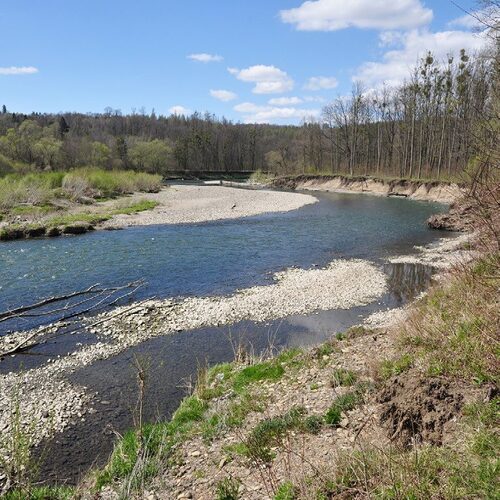
Koutný J.: Skalička Side Dry Water Reservoir Phenomenon – An Issue and Opportunity
Particularly in the early 20th century, the original branching and meandering Bečva River (eastern Moravia) had been continuously changed from a point of view of water management. The riverbed was straightened and shortened to the current 61.5 kilometres, river arms and meanders were cut off or filled. Thus, water runoff was accelerated and riverbank enforcement and big weirs caused deep erosion. In 1997, the Bečva River Basin suffered from disastrous floods. At present, the Skalička Waterworks has been under preparation: its main task is to transform flood rate in the Bečva River. Despite selecting one of the proposed options, building the waterworks shall substantially negatively affect the Hustopeče – Štěrkáč Site of European Importance (SEI, pursuant to Act No. 114/1992 Gazette on Nature Conservation and Landscape Protection, as amended later, the term for Site of Community Importance, SCI under the European Union’s Habitats Directive) as well as other parts of nature there. The State Nature Conservancy stands for three approaches: (1) It is necessary and extremely desirable to making the Bečva River natural as much as possible; (2) Due to its hydrological and flow morphological and geological patterns, the Bečva River offers reaching quickly and spontaneously the natural state; and (3) preparing a huge waterworks as the Skalička Side Dry Water Reservoir with a flexible facility is, increases the need of the Bečva River and its floodplain to become natural as much as possible. If the Skalička Side Dry Water Reservoir is designed as a flood control facility there is no other way but respect the fact and to consider environmental risk as a challenge to maximally support nature within the Bečva River Basin through mitigation and compensation measures in favour of nature. The extent of making the river and its floodplain natural should be generous enough, fully reflecting the extent of the technological intervention and its future impacts on the river ecosystem.
Plesník J. & Plesníková M.: Artificial Intelligence in Nature Conservation
Artificial Intelligence (AI) has already proven to be a truly transformational and value-enhancing technology in a variety of applications. In biodiversity conservation and management it can dealt with genes, individuals, populations and ecosystems. For underfunded conservation scientists and nature conservationists, AI provides an attractive alternative to manually processing huge troves of data, such as camera trap images or audio recordings. For nature conservation purposes, AI has been most often used to identify wildlife species and in some cases individuals from digital information gathered by current remote sensing tools. Thus, data collected by citizen science can be quickly and effectively processed. The same procedure is applied when Ai assesses state, changes and trends in various habitat/ecosystem/land cover types, e.g. forests, wetlands, grasslands, mangroves or coral reefs. In addition, AI can help rangers to combat wildlife poaching and trafficking in protected areas. The article main AI applications available for nature conservation including their web addresses. Moreover, it also discuss AI’s weaknesses.
Nature Conservation Legislation
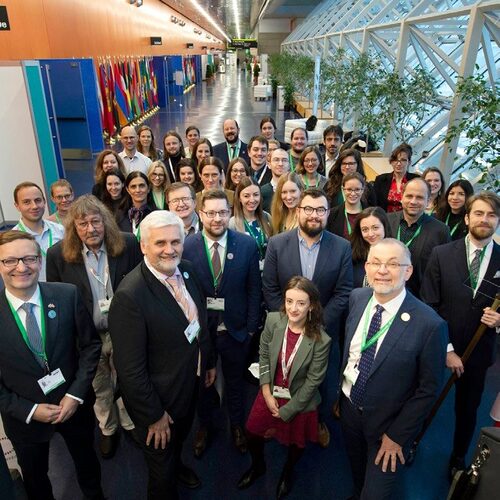
Miko L. & Plesník J.: Look Back at the Presidency of the Czech Republic in the Council of the European Union
Due to covid-19 pandemic, many meetings of Multilateral Environmental Agreements including those dealing with various issues related to biological diversity and of some United Nations bodies had to be postponed and rescheduled. Therefore, they heavily accumulated in the second half of 2022. The Czech Republic implemented its already second presidency in the Council of European Union (CZ PRES 2022) just between 1 July and 31 December 2022, thus facing an unprecedented challenge. During the CZ PRES 2022, the 9th Session of the Plenary of the Intergovernmental Science-Policy Platform on Biodiversity and Ecosystem Services (IPBES) was held in Bonn, adopting reports from thematic assessment of the sustainable use of wild species and from the methodological assessment regarding the diverse conceptualization of multiple values of nature and its benefits. In Prague, an informal meeting of EU ministers of the environment was organized in July 2022 aiming, inter alia, at adaptations to climate change, nature and biological diversity conservation and environmental impacts of war in Ukraine while a meeting of EU nature directors’ was held a month later dealing particularly with nature restoration and protected area management: during both events a field trip were offered to participants. The 8th Session of the Meeting of the Parties to the African-Eurasian Migratory Waterbird Agreement (AEWA) enhanced migratory water bird protection and conservation in Budapest in September 2022. At the 68th Meeting on the International Whaling Commission (Portorož, Slovenia, October 2022) the Czech Presidency, on behalf of the EU, successfully managed adoption of decision trying to reduce marine plastic pollution impacts on cetaceans and marine habitats. In November 2022, the 14th Meeting of the Conference of the Parties to the Ramsar Convention on Wetlands taking place in a hybrid format in Wuhan, China, and in Geneva endorsed wetland protection, conservation and sustainable use all over the world. Heavy negotiations carried out during the 19th meeting of the Conference of the Parties to CITES in Panamá City (14–25 November) resulted in strengthening conservation of wildlife species threatened by the international trade. The 42nd Meeting of the Standing Committee to the Bern Convention discussed various nature conservation issues in Europe. Finally, three weeks of the United Nations Conference on Biodiversity, particularly the 15th Meeting of the Conference of the Parties to the Convention on Biological Diversity, co-organised by Canada and China in Montreal during the last month of 2022 successfully finished by adoption the Kunming-Montreal Global Biodiversity Framework, a historic deal and a key international policy document on the topic. Special thanks to the all Czech Republic team members for their efforts, dedication, enthusiasm and hard work during the CZ PRES 2022.
Jelínková J.: Direct Legal Actions of Associations as Non-Participants of the Administrative Proceedings
Before amended by Act No. 225/2017 Gazette, Act No. 114/1992 Gazette on Nature Conservation and Landscape Protection allowed the public through environmental associations to participate in all the proceedings which could affect interests of nature and the landscape protected according to the Act. During recent debate on the Act on the Unified Environmental Permission it probably would not possible to bring back Article 70 paragraph 3 into the original state. Thus, direct legal actions by environmental associations against issuing permits for a building intention pursuant to the new Building Act shall be the only tool for defending right for the favourable environment through “the established local environment association”, e.g. in the case of an intervention in a Significant Landscape Element or landscape scenery/character. Thus, up-to-date experience from currently establishing administrative court practice is an important hint for associations, building owners, builders, State Nature Conservancy/Environmental Protection authorities and Building Offices. From the court practice having been formed it has been already at present clear that if there is a strong relation of an association to a site affected by the intention such legal actions are admissible and courts dealt with their legitimacy.
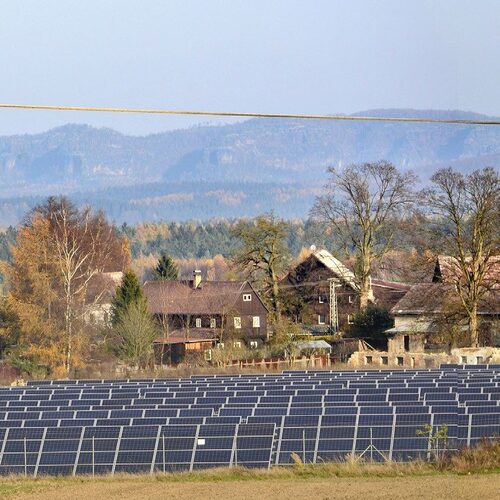
Šíma J. & Pelc F.: Information on Current European Union’s Legislation on Renewable Sources as Related to Nature Conservation
Use of renewable energy sources (RES) is one of the European Union’s long-term energy and environmental policies which should aim for carbon neutrality and climate change mitigation. In relation to energy crisis caused by the Russian Federation’s war of aggression against Ukraine and necessity to increase the EU’s energy independence Council Regulation (EU) 2022/2577 laying down a framework to accelerate the deployment of renewable energy sources was adopted 22 December 2022. The regulation should be complemented by standard nowadays debated revision of the EU Renewable Energy Directive, also known as RED III. Provision on overriding public interest set in Article 3 definitely aims at highlighting urgent need to develop RES and at preferring their construction and operation where these are not related to significant impact on nature and the environment. One of possible approaches is delineation areas for accelerating the deployment of RES, the so-called go-to zones as included into the RED III revision having been under preparation. Based on expert/technical background the areas should be suitable for the deployment and development of RES but at the same do not significantly affecting the environment or the latter can be significantly mitigated. In such areas permitting should be as simple as possible, thus to facilitate and accelerate RES development.
Kárník V.: Dispute on Leaves Falling from Open Public Space to a Private Garden
The article analyses the topical civil judicature on the issue dealing with leaves falling down from a municipal alley to a private plot. In the difficult question of collision of civil and public points of view, the lower court had decided that it is possible to assign to the town to remove fallen biomass. Moreover, the appellate court judged the issue in a different way and returned the case to further procedure. The plaintiff argued that crowns of the trees significantly extend over a plot of the complainants causing falling down of huge amount of leaves, achenes and branches on the private plot of the complainants, namely on an ornamental garden, a swimming pool and in gutters of a garden cabin and of a family house for most of the year. The complainants have to permanently remove the biomass fallen down to avoid weed infestation of the garden due to high germination capacity of achenes, contamination and consequent damage to the swimming pool plant and filling the gutters. The appellate court concluded that if in such an exceptionally and untypical case courts have been continuously dealing with since 2017, there is no other solution which would in a reasonable and fair for the litigants, particularly if the tree cannot be felled, trimmed or pruned, a solution to compensate damage caused to the molested can be considered. It is to be hoped that the problematic social consequences of the above repealing the judicature will be removed during the further deciding by court and the collision of public and civil points of view of woody plant occurrence will be successfully bridged. Moreover, the dispute has been continuing burdening both the litigants.
Czajkowski J.: Inputs from Nature Conservation in Ombudsman’s Practice
Also in the Czech Republic, citizens submit to the ombudsman a hug range of inputs including those dealing with nature conservation and landscape protection pursuant to Act No. 114/1992 Gazette on Nature Conservation and Landscape Protection, as amended later. The first case described in the article highlights an interesting issue of geocaching and an unfavourable impact which can pose on nature. Another story deals with woody plant cutting when possibly well-intended general restoration of public greenery in a municipality can easily turn to excessive impacts on the environment and human well-being. The last case reflects tramping in Protected Landscape Areas. A certain conflict between human activities on the one hand and nature on the other and related fears of maintaining nature and the landscape in desirable, i.e. well-preserved state is a common denominator of all the above cases.
From the History of Nature Conservation

Plesník J.: The Anniversary Which Should Not Be In Any Case Forgotten
On 20 June 1922, a group of dedicated and visionary conservationists concerned about the plight of the world’s birds and the wider environment came together to form an international movement in London. Rooted in the foundations of a handful of campaigning national organisations, e.g. the Bombay Natural History Society, Royal Society for the Protection of Birds, current National Audubon Society or Vogelbescherming Netherland, the International Committee (later Council) for Bird Preservation (ICBP) steadily gathered momentum and evolved into a powerful global voice for nature through its national sections established in many countries all over the world, i.a. in the former Czechoslovakia in 1925. In 1985, ICBP opened discussion about a new direction for the organization, as a network of strong allied national organisations, and relaunched it as BirdLife International. Its new name and logo was established in March 1993. Today the BirdLife family is at its strongest, with 119 Partners around the globe working to protect birds and their habitats in every continent thus being one of the most important international conservation NGO. Since 1998, the Czech Society for Ornithology has been a BirdLife Partner having been developed itself into a modern NGO since the early 1990s, e.g. playing a prominent role in establishing the EU Natura 2000 network in the Czech Republic.
Zajíček P.: Karel Josef Jurende – A Publicist, Propagator of Caves and Naturalist
Karel Josef Jurende, a very popular Moravian publicist and naturalist passed away 180 years ago. His activities have been rather neglected although he wrote and published a lot of at that time topical geographic, ethnographic and natural science information, data and descriptions. Its publications were accompanied by beautiful graphic works. Jurende’s unique contribution was not based on new knowledge and discoveries but particularly on popularising often highly scientific, technical and expert information which had been already known. He personally travelled to many sites and areas and was able to gather and present a lot of information on various topics from all over the world. K.J. Jurende not only described colourfully and attractively facts from natural science but he also highlighted their importance. Thus, he was able to spread the beauty of nature among various social layers of the literate population.
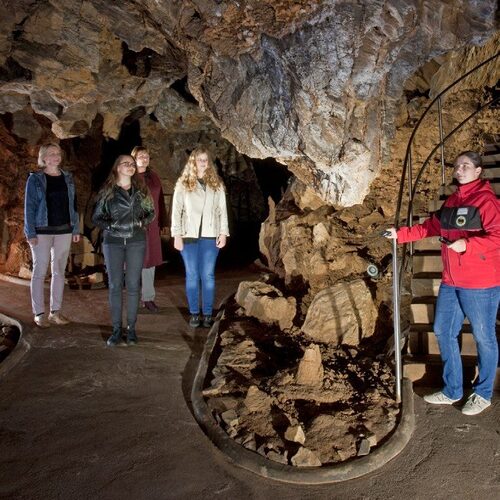
Šimečková B.: The 110th Anniversary of Discovering the Zbrašov Aragonite Caves
The Zbrašov Aragonite Caves at the village of Teplice nad Bečvou (Central Moravia) had been discovered at the turn of the years 1912 and 1913 and became a show cave in 1926. The length of visitor route is 375 meters, the length of the up-to-know cave system being 1 435 meters. They are part of the Zbrašov Aragonite Caves National Nature Monument declared in 2003. Since 2006, they have been managed by the Cave Administration of the Czech Republic established by the Ministry of the Environment of the Czech Republic. As standard part of show cave management, measures are implemented there, e.g. regular speleoalpinistic checks of vertical chimneys above the visitor route, special recovery spraying to protect aragonite decorations, lampenflora eradication along the visitor route and various one-time interventions to minimalize impacts of older technological measures to make a cave accessible to visitors. Influxes of the acidulous mineral water into the cave space have been documented. On the surface, rock outcrops above the access path and an operational building are regularly checked, individual elements of visitor infrastructure are step-by-step restored, etc. In the future, it is necessary particularly to modernize the current system monitoring microclimate and CO2 there and to restore the operational building.
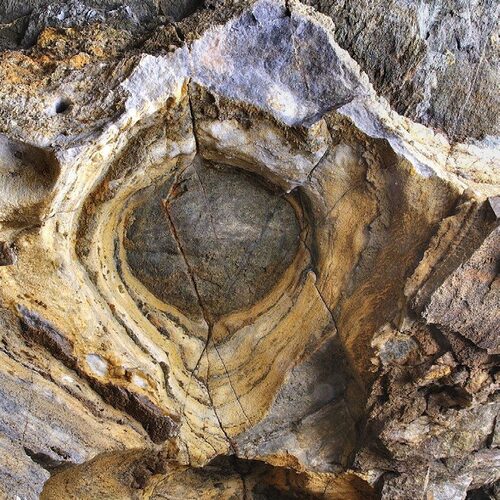
Zajíček P.: A Hundred Years since Discovering the Balcarka Cave
In the Moravský kras/Moravian Karst (South Moravia) there are many remarkable features attracting human attention since time immemorial, e.g. the Hřebenáč Rock, Kůlna Cave entrance, Macocha/Stepmother Abyss and many others. They also include a conspicuous limestone ridge very close to the township of Ostrov u Macochy called the Balcar’s Rock. A hundred years ago the first speleological findings had been made there consequently resulting in step-by-step uncovering an underground labyrinth of the Balcarka Cave. Josef Šamalík, farmer and local patriot began to examine the selected sites: 16 June 1923 he penetrated in small underground space, later named as Popeluška/Cinderella. In the mid-1930s he discovered other Cave Balcarka’s parts with extraordinarily rich and colourful dripstone decoration. The parts called the Galerie/Gallery and the Přírodní chodba/Natural Corridor are among the most beautiful underground spaces of the whole Moravský kras/Moravian Karst. At present the Balcarka Cave is together with other thirteen show caves managed by the Cave Administration of the Czech Republic.
Drbal K.: 160 Years since the Discovery of the Chýnovská jeskyně/Chýnov Cave
The Chýnov Cave is located in South Bohemia on south-western edge of the Českomoravská vrchovina/Bohemian-Moravian Highlands near the town of Chýnov. The then curators of the National Museum in Prague, Antonín Frič and Jan Krejčí describe descending into the Chýnov Cave in Živa journal in 1863 as follows: “We had been descending down giant or devil’s stairs by brave long-winded steps, coming down huge rocks fallen from ceiling: from far away, water glistened there reflecting rays of torches and announcing to us that we have been at the deepest site of the cave.” During 160 years the cave experienced various types of use and research by humans: last but not least a path accessible for visitors has been step-by-step modified there. Last time it happened in 2007 when an exit gallery was blazed, crossing hanging small bridges were built and the Malá kaple/Little Chapel became accessible for visitors including adjacent upper corridors of the cave. A rich exhibit in an underground part of the former locomotive shed from the Pacov Hill quarry serving as a visitor centre demonstrates direct connection between quarrying and processing limestone and the discovery of the cave.
Zajíček P.: 300 Years since the First Climbing Down the Macecha/Stepmother Abyss
The Macocha/Stepmother Abyss in the Moravský kras/Moravian Karst (South Moravia), one of the unique natural formations of Europe, has had a rich history. Until 1914, its bottom was available only from above using ropes or ladders. According to records, the first people had climbed down reaching the bottom in 1723. The exploration was conducted by Minorite monk Lazar Schopper from the city of Brno and his valet and local farmers also participated in it. The climbing down definitely is among the exceptional events in the Moravský kras/Moravian Karst history. Similarly important is a manuscript by Josef Melnický recording the event 52 years later. Unless any record confirming the earlier climbing down the abyss is found, the Lazar Schopper’s exploration has been continuing to be considered as the very first.
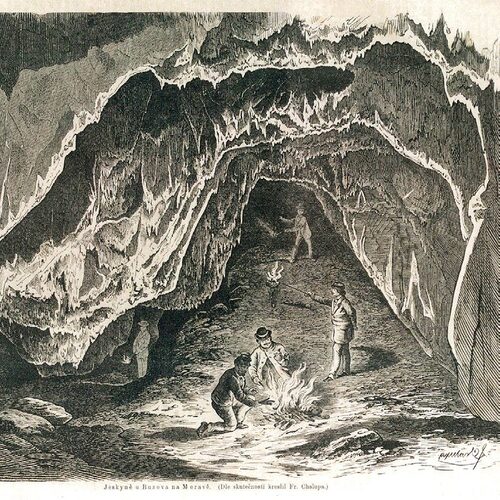
Koudelka M.: The Svěcená díra/Sanctified Hole near the Village of Javoříčko Has Been Known for More than 150 Years
The Svěcená díra/Sanctified Hole is the oldest known part of an underground labyrinth in the Javoříčko Caves (Central Moravia) which has been up to now a part of a visitor path. The caves display a long and less known history which has been often preserved only in folk tales and legends. The first description of the hole including a picture dates back to 1873 only. The less tempting underground space was a principal key to discovering the Javoříčko Caves themselves in 1938. At present the Svěcená díra/Sanctified Hole is an integral part of the comprehensive Javoříčko Caves reaching almost six kilometres in the length in three storeys there. The caves are located within the Špraněk National Nature Reserve and Site of European Importance (pursuant to Act No. 114/1992 Gazette on Nature Conservation and Landscape Protection, as amended later, the term for Site of Community Importance, SCI under the European Union’s Habitats Directive). The Svěcená díra/Sanctified Hole was a site from where other some kilometres of other underground spaces full of rich dripstone decoration were step-by-step discovered.
Focusing on the Public
Melichar J., Pavelčík P., Zahradník D., Banaš M., Misiaček R., Hamanová J., Slaba M. & Kováčová V.: Declaring the Soutok/ Morava and Dyje/Thaya Rivers Confluence Protected Landscape Area Can Support the Region’s Development
The article presents results of the study entitled Assessment of socio-economic impacts of declaring the Soutok/ Morava and Dyje/Thaya Rivers Confluence Protected Landscape Area initiated by the Nature Conservation Agency of the Czech Republic. After declaring the PLA in the natural area covering 192 km2 a step-by-step increase in number of visitors by 48%, in one-day visits number even by 61% is supposed. Apart from positive economic effects it can impact nature conservation and landscape protection there, e.g. by overtourism when ecosystems are disturbed and degraded, traffic jam appear or visitor infrastructure is massively built; consequently cost of living can increase in local people. Also from the above reasons attendance of the Soutok/Confluence should be continually monitored and attention should be paid to possible negative impacts on ecosystems.
Zajíček P.: On Boats from the Macocha/Stepmother Abyss bottom through the Punkva Caves
The Punkva Caves discovered in 1909 are among the most attractive tourist destinations in Europe. In 1914, a bottom of the Macocha/Stepmother Abyss had become available for tourists as a part of the visitor path there and seven year later, new parts of the caves passed by a subterranean river in direction to the abyss were discovered there. Only in 1933, after pumping out the Zlý sifon/Bad Conduit, the abyss bottom and a well of the Punkva River were interconnected. In the same year, a tunnel above the Zlý sifon/Bad Conduit was bored and in July, boat journeys through the Punkva Caves started in a form as it stands now. The Punkevní jeskyně/Punkva Caves are currently the most visited show cave in the Czech Republic. In the early 20th century nature conservation had been only in its beginning and declaring protected areas in the then Austrian-Hungarian Empire or young Czechoslovakia were rather an exemption. At present similar measures in caves would be considerably questionable if would ever at all be feasible. There is no other way but to respect the current state of the art and to try to minimize negative effects on the cave ecosystems, whether the “windy door” system, microclimate monitoring and its evaluation or long-term research on visitors’ impacts on the cave microclimate.
Petrovský O. & Pelc F.: The Ivan Dejmal Foundation for Nature Conservation 30 Years Old
The Ivan Dejmal Foundation for Nature Conservation established originally as the Foundation for the Conservation and Restoration of the Jizera Mountains has been helping to fund nature heritage conservation and management for three decades. Ivan Dejmal was the Minister of the Environment of the Czech Republic in 1991 – 1992, a signatory to Charter 77, spending four years in prison on charges of "subversive activity against the Republic in the early 1970s). Until now the Foundation has distributed directly more than CZK 32 million (EUR 1.3 million) among hundreds of small or larger projects. Because providing funds for co-financing, other larger projects totally reaching CZK 21 million (EUR 0.8 million) have been implemented. Thus, at present it is one of the largest foundations dealing with nature conservation in the Czech Republic. Among the projects implemented, these should be mentioned: (i) Saving the native gene pool of local woody plant species of the Jizerské hory/Jizera Mts. (1993-1998), Foundation’s contribution CZK 2 million (EUR 82,000); (ii) Jizerské hory/Jizera Mts. peat-bog restoration (since 2016), Foundation’s contribution of CZK 1.6 million (EUR 66,000) allowed to implement a project totalling CZK 7 million (EUR 287,000) – the Association for the Jizera and Ještěd Mountains; (iii) Saving the Sedmihorky wetlands (2019 – 2022), thanks to Foundation’s contribution of CZK 368,000 (EUR 15,100) a project totalling CZK 3.3 million (EUR 135,000) could be implemented – the Sedmihorky Wetlands Land Trust and the Society for Jizera Mountains; (iv) Planting species-rich forest in the Liberec area (since 2015), Foundation’s contribution of CZK 7.2 million (EUR 295,000) has been helping to implement a project totalling CZK 9 million (EUR 369,000) – Jan Duda.
Prach J., Konopásek Z. & Říha C.: How to Build in the Landscape. Developing a Web Application to Support Regulation of Building Activities in Protected Landscape Areas
Controlling building activities in Specially Protected Areas (PLAs) aiming and preserving the landscape scenery/character is an important agenda of the State Nature Conservancy authorities. The Nature Conservation Agency of the Czech Republic through its PLA Administrations protects public interests which cannot be always clear at first glance. The procedure between a citizen-builder and a local authority causes a lot of tensions.
The article shows outputs of the project funded by the Technology Agency of the Czech Republic which was presented in Ochrana přírody/Nature Conservation Journal 4/2021 (“How to Build in a Protected Landscape Area.” From a Regulation to Practice). They include a web application jakstavetvkrajine.cz introducing local values of the landscape scenery/character and principles or regulations in the context in a sensitive way and user-friendly. It is based on preventive studies on landscape scenery/character assessment which have been elaborated by the individual PLA Administrations. The web interface allows to generate a tailored document to be printed. The application could contribute to better understanding of differentiated approach: why is a similar building unwanted in some parts of the PLA while in some of them it is not a trouble anyhow.
Starý M.: The EUROPARC Federation Fifty Years Old and in Its Prime
The largest professional network of protected area managers in Europe (and probably also in the world) celebrates 50 years since its establishment. Joining national parks and nature reserves, sustainable development, all being roofed by transboundary cooperation. Therefore, more and more protected area mangers have been joining the EUROPARC Federation, having been getting across borders and making friendship fifty years. Nowadays, the EUROPARC Federation has more than 400 members in 36 countries. They are not only protected area managers themselves, but also governmental institutions, ministries, non-governmental and private organisations or individuals. Step by step, the Junior Ranger programme aiming at communication with, education of and raising awareness among children, the Transboundary programme targeting transboundary cooperation sustainability and high quality or the European Charter for Sustainable Tourism in Protected Areas have been developed. Each of them displays defined quality standards as well as checking mechanisms which are carefully applied during their long-term implementation. Celebrating the 50th anniversary naturally peaked at the EUROPARC 2023 Conference which was held in Leeuwarden in the Netherlands in early October 2023 under the fully appropriate motto Tribute to our landscape, where nature and people meet in harmony.
International Nature Conservation
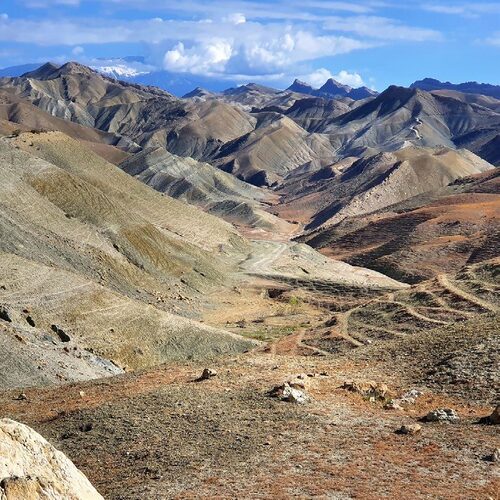
Pešout P.: Nature Conservation in Uzbekistan
The current Republic of Uzbekistan boasts from natural science point of view valuable areas of international importance. During implementation of the Ramsar Convention wetlands of international importance (Ramsar Sites) have been identified there, the Uzbekistan Society for the Protection of Birds has delineated 48 Important Bird Areas covering of 4.6% of the Uzbekistan’s territory and nature reserves in the Tian Shan Mts. have been inscribed on the UNESCO World Heritage List. The country elaborated a national programme/strategy and action plan on biodiversity. The Uzbekistan’s legislation also allows establishment of private protected areas and natural areas dedicated to wild plant planting and wild animal keeping and breeding, e,g, two for breeding MacQueen’s bustards (Chlamydotis macqueenii). Private protected area management is funded by both legal and natural persons. Management of nationally important protected areas (PAs) is carried out by the State Committee and bodies managed by it and by inspectors, other PAs are managed by local authorities and self-governing bodies, in some case by land owners themselves. Moreover, PAs are preferentially owned by the State and pursuant to the legislation they are accessible to citizens, but entrance into them can be limited or prohibited by the State/Public Administration authorities. Content of management plans for PAs is given by the State Committee which also check their implementation in practice. Monitoring and research in PAs are coordinated by the Academy of Sciences of Uzbekistan and are financed from the Fund. Nature conservation and landscape protection is among the Uzbekistan’s priorities which has been evidenced by a recent significant increase in the PA coverage and by many threatened species action plans/recovery programme implementation. The future will show how the still rich biodiversity has been maintained despite continuing desertification and increasing demand of citizens in the rapidly developing Central Asian country.
Drapaljuk A., Vasyljuk O. & Kuzemko A.: How the War Has Affected Ukrainian Protected Areas
The damage caused to nature as a result of the full-scale military invasion of the Russian Federation started on February 24, 2022 has had a pan-European dimension and the consequences of hostilities for biodiversity will be seen across the continent. The network of protected areas in Ukraine is an essential component in preserving Europe’s biodiversity protectimg mountain ecosystems within the Carpathian and Crimean Mts., key areas for migration and nesting of waterfowl on the coast of the Azov and Black seas, peat-bogs, natural forests on Polissya, and unique steppe ecosystems on the East and South of Ukraine. During the eleven months of the war, Russian aggression caused damage to the environment at more than USD 46 billion (CZK 1 trillion). Such a figure is calculated according to the methodologies that determine the amount of damage caused to land, water and atmosphere. The total amount of damage caused by soil pollution is more than USD 18.2 billion (CZK 408 billion) while that by air pollution is USD 26.4 billion (CZK 591 billion). For water pollution the damage is estimated at more than USD 1.4 billion (CZK 32 billion). Some types of damage have still been impossible to assess. For example, half a million hectares of forests are under occupation and in the hostilities zone. According to the Ministry of Environmental Protection and Natural Resources of Ukraine, Russian invaders e.g. destroyed 80% of the Sviati Hory National Nature Park, Donetsk region. Even in such conditions, protected area managers continue to work. In addition, with the beginning of the large-scale Russian invasion, protected areas took on another mission – to help people who lost their home: protected area staff has organized a shelter for over 60,000 internally displaced persons. The authors are grateful for the support from the European nature conservation community – governments, protected areas administrations, NGOs, and individual conservationists which provides an opportunity and inspires them to continue implementing nature conservation measures even under the conditions of threat to physical survival.
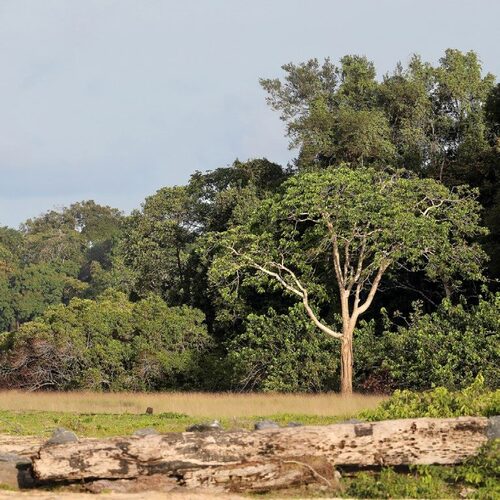
Pelc F., Tesař T. & Ambrozek L.: A Hope from Gabon. Protected Areas, Ecosystem Services and Diversification of Economy
Within Africa Gabon is a relatively small country (267,670 km2) located on the Equator in the Gulf of Guinea: its population is 2.2 million. About 80 % of the country’s territory is covered by primary of secondary rain forests and lesser part by savannah. Only 1.2 % is used as arable land. The country harbours rich sources of oil and minerals (coltan, manganese) and the standard of living is among the highest in Africa: Gabon is economically quite viable and politically relatively stable. Nature conservation has been quite developed in the country. There is a protected area network relatively well managed by the National Agency for National Parks (ANPN) with about 800 staff members. The total protected area coverage including Ramsar Sites (Wetlands of International Importance) is 22% of the country’s territory. Thanks to effective nature conservation and low human population density in this relatively small country two thirds of the African forest elephant (Loxodonta cyclotis) population living on the continent and two thirds of the global Lowland gorilla (Gorilla g. gorilla) population occur.
In October 2022 the Czech Republic’s delegation met representatives of the Gabonese Government to discuss possible cooperation in nature conservation. The Nature Conservation Agency of the Czech Republic (NCA CR) presented simplified information system for gathering data on the selected umbrella species. Together with the Faculty of Environmental Sciences, Czech University of Life Sciences Prague the NCA CR can offer experience raised during elaboration of a feasibility study in Zambia as part of the Czech Official Development Assistance and exchange of practical experience among experts from both countries was also agreed.
Plesník J.: The High Seas Will Be Finally Protected: But How?
On 4 March 2023, after a long debate in New York the United Nations member states finally agreed to protect the high seas. These include the seas outside national borders and the economic zone, which reaches up to 370 kilometres off shore. Until that time, the seas outside of that area were not susceptible to any legal framework, although comprising two thirds of all oceans and will now finally be protected by 2030. The talks to come to an agreement have been going on for over 20 years. Under the United Nations Convention on the Law of Sea (UNCLOS) the United Nations High Seas Treaty is a legally binding instrument for the conservation and sustainable use of marine biological diversity in areas beyond national jurisdiction.
The treaty adopted on 19 June, 2023 addresses four themes: (1) Marine genetic resources, including the fair and equitable sharing of benefits; (2) area-based management tools, including marine protected areas (MPAs); (3) environmental impact assessment (EIA) of commercial activities on the high seas; and (iv) capacity building and transfer of marine technology. The agreement now makes possible to protect 30% of the oceans by 2030. Moreover, it will only enter into force once 60 countries have signed up and legally passed the legislation in their own countries. In addition, it has not been perfectly clear yet how key provisions (e.g. establishing, effectively managing and financing MPAs and their proportion dedicated to strict protection, applying international EIA, measures to monitor and enforcing fulfilling the obligations from the treaty) will be implemented. Thus the treaty definitely is an important step towards maintaining and preserving high seas ecosystems but is has to be more elaborated.
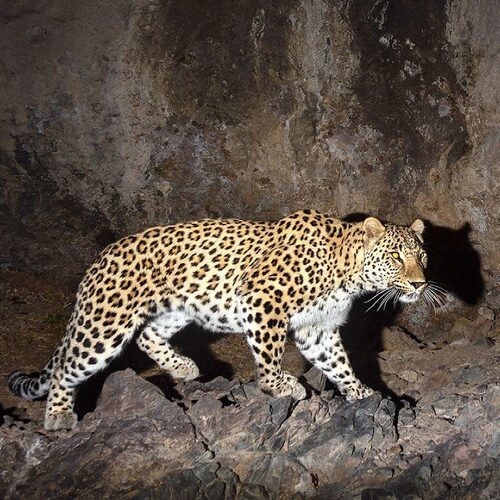
Růžička T., Chlapek J., Lacina D., Kušnírová T., Filipová P. & Zachystalová L.: Nature Conservation Agency of the Czech Republic Contributes to Armenian Biological Diversity Conservation
In 2021–2023 the Nature Conservation Agency of the Czech Republic together with the Finnish Environment Institute implemented two-year project entitled as Strengthened protection and sustainable use of biodiversity in Armenia in line with the European standards funded from the EU Twinning programme. The Ministry of the Environment of Armenia was the main partner and a beneficiary of the project’s outputs. The project’s activities aimed particularly at the approximation of the national legislation with the EU acquis, optimizing institutional development and governance, increasing expert and technical background and at raising awareness on proposed legislation and institutional changes strengthening biodiversity and nature conservation. In September 2022 a new task was added, namely developing National Biodiversity Strategy and Action Plan. In collaboration with the National Academy of Sciences of the Republic of Armenia, main risk factors threatening biological diversity in the country were identified: to eliminate them, many measures according to branches of activities were proposed, e.g. species protection, protected areas, legislation, institutional infrastructure or ecosystem services and landscape permeability for movements of organisms. The Armenian Ministry gained, inter alia, tools for implementing current nature conservation based on the suitable legal framework, technical/expert background and good communication with partners and the general public.
Plesník J., Klouček O., Ucová S., Říhová P. & Kučera J.: CITES Fifty Years Old. Notes on What Was, Is and Will Be
Illegal and unsustainable wildlife use is considered one of the most important global driver of biological diversity decline and loss. The Convention on International Trade in Endangered Species of Wild Fauna and Flora (CITES) was opened to the world’s governments for signature on 3 March, 1973 in Washington, D.C. and entered into force on 1 July, 1975. Heralded as the Convention to protect all species from overexploitation due to international trade, the agreement marked global recognition that wildlife overconsumption, primarily by profit-seeking industries, threatens wildlife. The Convention’s successes include, inter alia, reducing elephant poaching with the 1990, commercial ivory trade ban, aiding spotted cats, crocodilians and giant otters, and drawing attention to and stimulating conservation efforts for numerous species. At present, almost 40,000 wild plant and animal species are protected by CITES against over-exploitation through international trade.
The Czech Republic plays in international wild fauna and flora trade a prominent role. It is not only due to geographical location, but also highly developed and very popular plant growing, cultivation and planting and wild animal breeding. Therefore in the early 1990s, there had been cases of illegal wildlife trading and smuggling citizens of the former Czechoslovakia, later the Czech Republic were involved in. Act No. 16/1997 Gazette fully covering the commitments set by the CITES entered into force and all CITES national authorities started to effectively implement the Convention, Since 2004, after joining the European Union, the implementation has been enhanced by the respective EU legislation and the national institutions have been internationally recognized and some of them awarded.

Vlašín M.: Vertebrates in Vicinity of the Municipality of Svatá Helena, Czech Banat, Romania
The region called Czech Banat is a part of south-western Romania where Czechs begun to settle two centuries ago: despite the long distance from original homeland, they have maintained not only native language, but also many traditions and customs having been forgotten in the Czech Republic. In total, six Czech municipalities are at present there.
Vertebrate fauna in vicinity of the municipality of Svatá Helena is species rich because a karst cave system, many forests and overgrown inaccessible gorges, valleys and slopes provide tetrapod vertebrates with suitable habitats. Remarkable species include e.g. the Hermann’s tortoise (Testudo hermanni), Horned viper (Vipera ammodytes), Caspian whipsnake (Dolichophis caspius), Short-toed snake eagle (Circaetus gallicus) and the Alpine swift (Tachymarptis melba). Among mammals, rich bat fauna of the region should also be mentioned. Of mammals, birds, reptiles and amphibians occurring there, many are listed in the Red List of Threatened Species in Romania or protected by both Romanian and European Union’s legislation. For maintaining vertebrate species richness there, it is necessary to keep traditional measures in landscape management, particularly agricultural ones.
Zeidler M.: How to Maintain Tertiary Habitat in the Quaternary Period
Macaronesian laurel forests (natural habitat type code 9360 in Annex I to EU Directive 92/43/EEC on the conservation of natural habitats and of wild fauna and flora, commonly known as the Habitats Directive), also called laurisilva, is humid to hyper-humid evergreen forests formed on the Macaronesian islands (the Azores, Madeira, and the Canaries). The long-term stable environment with a unique combination of controlling environmental factors was preserved on the isolated islands. This habitat is extremely rich in flora (and fauna) species most of them being ancient and endemic. The species rich and highly endemic vegetation has been interpreted as being basically of relict character from the sub-tropical Tertiary vegetation around the archaic basin of the Tethys Ocean. However, the Macaronesian laurel forests have been intensively exploited since Europeans arrived there in the 15th century. Extensive areas of forest were clear-cut to create farmland, while forest exploitation and livestock raising have degraded and impoverished the vegetation in terms of species composition. The conservation management consists of selective cuttings to improve regeneration of exploited stands, converting forest plantations into laurel forest, eradication and control of invasive alien species, recovery of threatened species, controlling some activities, and monitoring.
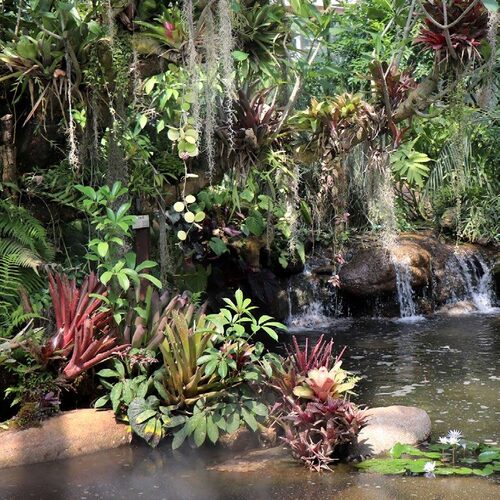
Plesník J.: Global Biodiversity Framework: Wishful Thinking or Desirable Impulse?
The United Nations Biodiversity Conference (15th meeting of the Conference of the Parties to the Convention on Biological Diversity, COP15) ended in Montreal on 19 December 2022 with a landmark agreement to guide global action on nature through to 2030. The Kunming-Montreal Global Biodiversity Framework (GBF) is a result of four-year consultation and negotiation process. The document builds on the Convention’s previous Strategic Plans, and sets out an ambitious pathway to reach the global vision of a world living in harmony with nature by 2050. Therefore, four overarching goals to be achieved by 2050 focus on ecosystem and species health including halting human-induced species extinction, the sustainable use of biodiversity, equitable sharing of benefits arising from the utilization of genetic resources, and on implementation and finance to include closing the biodiversity finance gap of USD 700 billion per year. The 23 targets to be achieved by 2030 include 30 per cent conservation of land, sea and inland waters, 30 per cent restoration of degraded ecosystems, halving the introduction of invasive species, and USD 500 billion/year reduction in harmful subsidies. In adopting the GBF, all Parties committed to setting national targets to implement it, while all other actors have been invited to develop and communicate their own commitments. The article presents strengths and weaknesses of, opportunities and threats to the GBF itself and concludes that GBF is a key challenge towards the transformative change.
Plesník J.: IPBES Discussed the Issue of Invasive Alien Species
On 2 September, 2023 in Bonn, the 10th session of the Plenary of the Intergovernmental Platform on Biodiversity and Ecosystem Services (IPBES) approved document entitled as Thematic assessment of invasive alien species and their control. The comprehensive report was produced by 86 experts from 49 countries, working for more than four and a half years: it draws on more than 13,000 references, making it the most comprehensive assessment ever carried out of invasive alien species around the world. According to the report, more than 37,000 alien species have been introduced by many human activities around the world: more than 3,500 of these are harmful invasive alien species – seriously threatening nature, nature’s contributions to people and good quality of life. According to IPBES experts, the global economic cost of invasive alien species exceeded USD 423 billion annually in 2019, with costs having at least quadrupled every decade since 1970. Invasive alien species have been a major factor in 60% and the only driver in 16% of global animal and plant extinctions that we have recorded yet. While 80% of countries have targets related to managing invasive alien species in their national biodiversity plans, only 17% have national laws or regulations specifically addressing these issues and 45% of all countries do not invest in the management of biological invasions. Therefore, the report highlights that future biological invasions, invasive alien species, and their impacts, can be prevented through effective management and more integrated approaches presented there.
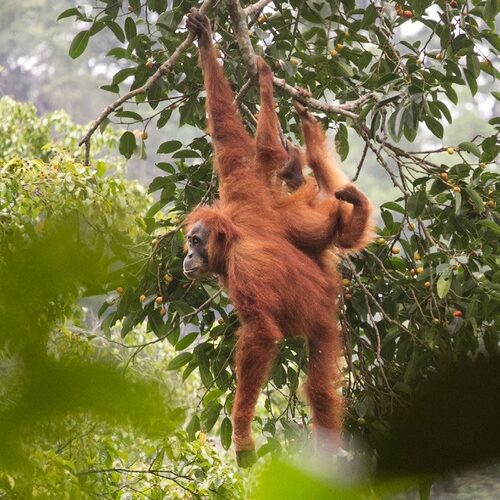
Čižmářová L.: Czech-Indonesian Cooperation in Nature Conservation in Sumatra
Indonesia is rightly one of the megadiverse countries, i.e. nations with extraordinarily rich biodiversity on global level, particularly with high species richness (number of species), thus harbouring the majority of Earth’s species and high numbers of endemic taxa. Unfortunately, precipitously large-scale deforestation, particularly due to making Oil palm (Elaeis guineensis) plantations and extensive illegal wildlife trade have resulted in high number of endangered wild animal taxa. Moreover a large part of the island of Sumatra has been covered by primary tropical rainforests. The Gunung Leuser National Park is the last area in the world where the Sumatran elephant (Elephas maximus sumatranus), Sumatran Rhinoceros (Dicerorhinus sumatrensis), Sumatran orangutan (Pongo abelii) and the Sumatran tiger (Panthera tigris sumatrae) have been still occurring: according to the IUCN, all of them are globally critically endangered. In 2014, the Czech-Indonesian non-profit organisation The Kukang Rescue Program started its field activities aiming at slow lories (Nycticebus spp.) conservation, but also deals with pangolins (Pholidota) protection and conservation. Close collaboration with local communities has proven to be key not only for wild animal endangered species.
Kapusta J.: The Largest Mountain Lake in the High Tatra Mountains Had Flown out Thousands of Years Ago
The largest lake in the High Tatra Mountains (North Slovakia) was the Studenopotocké pleso Mountain Lake which does not exist anymore and which vanished in a way not so common in Central Europe. Thousands of years ago, it had flown out through an eroded moraine dam-like wall. The main parameters and the most recent facts are provided by scientific reconstruction based on an analysis of digital model of the terrain. Creation and further existence of the Studenopotocké pleso Mountain Lake is closely related to mountain glaciers. The dam-like wall and shores of the lake consisted of huge moraine wall, i.e. glacier sediments reaching dozens of meters in the height. In the end of the last Ice Age where significant warming arrived the High Tatras glaciers begun to melt. As a result, rock matter they brought or pushed created huge moraine walls blocking up valleys with lakes. Powerful mountain streams particularly during periods of high flow rate step-by-step mechanically eroded the dam-like walls. From a long-term point of view, the mountain lake constantly decreased its water surface up to the moment when totally flowed out. Covering 0.45 km2 the Studenopotocké pleso Mountain Lake was definitely the largest lake in the whole Tatra Mountains, but it fully vanished due to a groove in the dam-like wall being 25 meters deep.



